
deseret.com $4.95 JUNE 2024 VOL 04 | NO 35 DESERET MAGAZINE UPC REFERENCE JANUARY JUNE NOVEMBER MARCH JULY DECEMBER APRIL SEPTEMBER MAY OCTOBER
THERAPY
THE TEEN
PLUS:
RETURN OF THE CONDOR: THE COMEBACK OF A WESTERN ICON IS
CAUSING
ANXIETY CRISIS?
ALAN J. HAWKINS CONFESSIONS OF A BORN-AGAIN TRAVELER
SOLITARY CONFINEMENT: A UNIQUELY AMERICAN PHENOMENON



























You have ideas. You have dreams. You just need a little help putting them into action. Fortunately, Utah is the startup capital of the world. Here, you’ll nd resources to elevate your small business to great heights. Now, let’s get started.

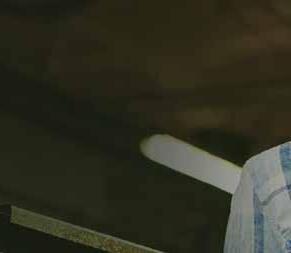


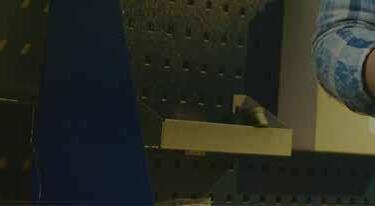






 natalia galicza
natalia galicza



“Incarcerated people who endure solitary confinement are 15 percent more likely to reoffend.”
RAPTOR’S RISE FROM THE BRINK OF EXTINCTION.
marlowe starling
JUNE 2024 3 46
THE
CONSIDER
CONDOR A
THE
ON THE COVER ILLUSTRATION BY OWEN DAVEY CONFINEMENT: 54
CONTENTS
by
38 ARE THE KIDS ALL RIGHT?
NEW DEBATE OVER THERAPY. by jean m . twenge
ALONE WHAT 22 YEARS IN SOLITARY CONFINEMENT DOES TO A PERSON. by
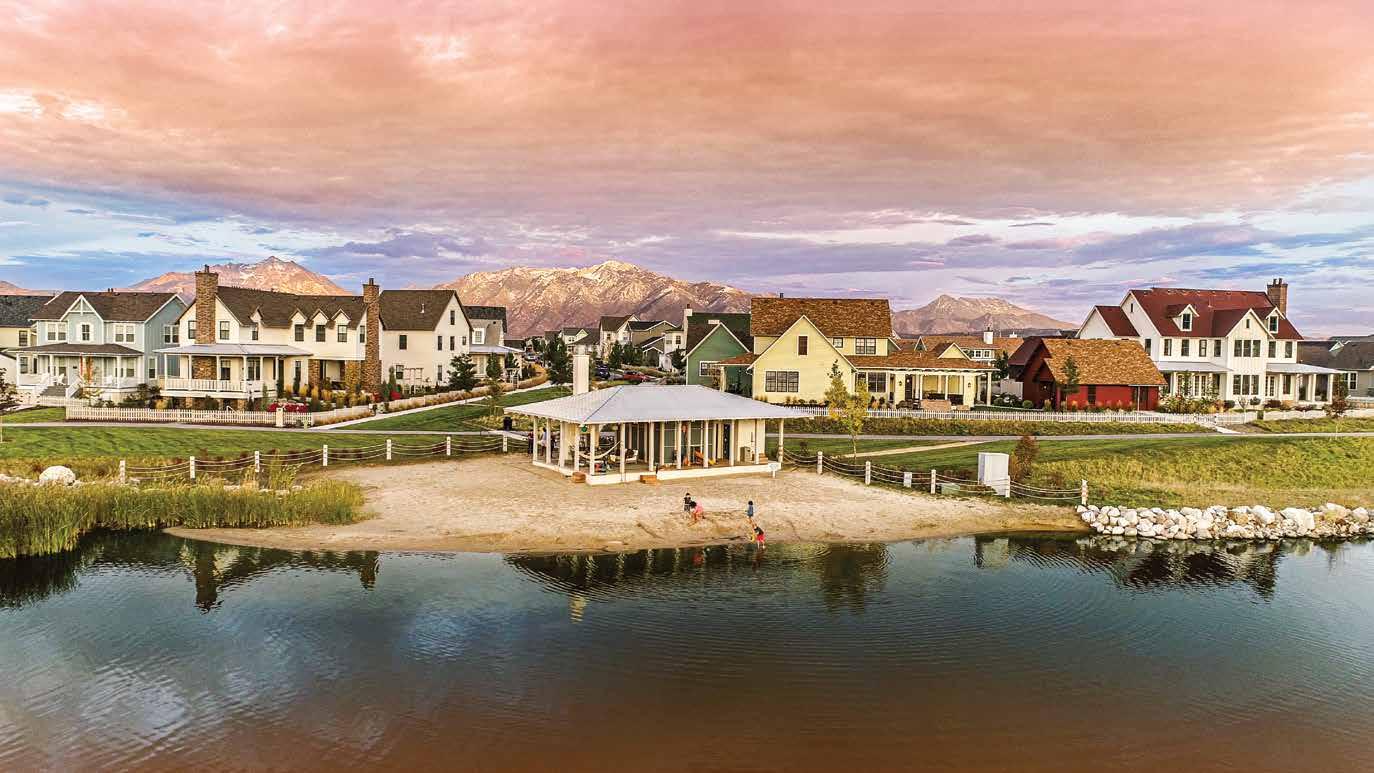





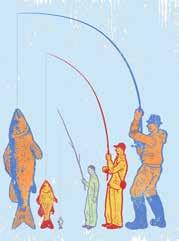
JUNE 2024 5 34 SEVEN WAYS OF SAYING by john belk AMBOS NOGALES A city where the border doesn’t divide. by natalia galicza LETTERS FROM THE FIELD IDEAS COMMENTARY POINT/COUNTERPOINT ODE THE LAST WORD CULTURE NATIONAL AFFAIRS THE WEST THE BREAKDOWN MODERN FAMILY WINDOW ON A HILL Salt Lake City’s unique photographic history. by joe marotta 72 CAST AWAY Ode to live bait. by ethan bauer 78 THE CHAPLAIN On spirituality in the military. by lois m collins 80 REIMAGINING EARLY EDUCATION An opportunity for conservatives, if they’ll take it. by frederick m hess and michael q mcshane 64 THE OPEN ROAD Confessions of a born-again traveler. by alan j hawkins 15 WATER WORKS What’s next for the dams that built the West? by clay grubbs 16 COLD COMFORT America’s shocking obsession with ice cream. by jennifer graham 18 THE DELICATE ART OF DOING NOTHING Boredom isn’t the enemy. by megan feldman bettencourt 20 SPACE FOR SALE I need a price check on the moon. by rebecca sohn 24 GLORY TO THE GRAND How the sand of the Colorado River gets under your skin. by heather hansman 28 “When borders close and policies change, families are separated.” 77 POETRY ON THE BRINK Facing the Social Security crisis. by andrew biggs 68 CONTENTS



Starling is an environmental journalist based in New York City. She writes about climate, conservation and culture. Her work has appeared in The New York Times, Sierra Magazine, the Miami Herald, PBS and The Associated Press. Her story about the fate of the condor is on page 46.

Hawkins manages the Utah Marriage Commission and is an emeritus professor of family life at Brigham Young University, where he published widely on the effectiveness of relationship education and developed educational programs for families. His commentary on the value of taking a vacation is on page 15.
Twenge is a professor of psychology at San Diego State University, whose research has been featured in The New York Times, USA Today and The Washington Post. She has authored several books, including “iGen,” “Generation Me” and “Generations.” Her critique of the new book “Bad Therapy” is on page 38.

A senior fellow at the American Enterprise Institute, Biggs is a former principal deputy commissioner of the Social Security Administration. In addition to academic publications, his work has also appeared in The New York Times, The Wall Street Journal and The Washington Post. His essay on Social Security reform is on page 68.
Sohn is a health and science writer based in New York City. Her work has appeared in Scientific American, Slate, Popular Science and The Verge, among others. She is a former science fellow at Mashable. Her report on the commercial development of the cosmos is on page 24.

Choi is an award-winning Korean/Canadian illustrator and printmaker based in London, specializing in visual narratives. She has won or been shortlisted for multiple international awards and exhibited at various galleries, including the Royal Academy of Art Summer Exhibition. Her illustrations appear on page 38.
6 DESERET MAGAZINE CONTRIBUTORS
SUNNU REBECCA CHOI
MARLOWE STARLING
JEAN M. TWENGE
REBECCA SOHN
ALAN J. HAWKINS
ANDREW BIGGS
Unleash your inner adventurer

Experience award-winning hospitality at America’s most pet-centric hotel.
Located in the majestic red rock splendor of Kanab (just 5 miles from Best Friends Animal Sanctuary), the Best Friends Roadhouse and Mercantile offers:
• Luxurious amenities for you and your pet
• Two dog parks with a splash zone
• Delicious vegan breakfast every morning
• Live music May through October
• Fun, unique merchandise
• Free daily Sanctuary tour shuttles
• Sleepovers with pets from the Sanctuary
Whether you want to volunteer with animals, bring home a new best friend, or enjoy a beautiful base camp within 90 minutes of three national parks, the Roadhouse is the ultimate option for animal lovers that supports the lifesaving work of Best Friends Animal Society.
Make your reservation today! bestfriendsroadhouse.org 435-644-3400
Winner - Best of State Utah
Best Motel 2022 & 2023, Best of the Best Hospitality 2023







Discover new gospel insights with Continuing Education InspirED. This growing online media library contains classes from BYU Continuing Education events and is now the only place to access BYU Adult Religion Classes. Start your free trial today! Elevate Your Understanding Explore the library at inspired.byu.edu Join Us August 19–23, 2024

OUT OF THE DARKNESS
Her name was Alice. She belonged to our Latter-day Saint congregation, and my dad and I were assigned to visit her once a month. I dreaded these visits. I was 14 years old, and the last thing I wanted to do on a Sunday afternoon was sit in the stuffy apartment of an elderly widow who seemed defined by one characteristic above all others: She was incredibly lonely.
Sometimes, as my dad listened patiently to stories Alice had shared again and again, I would study her family photos on the wall and imagine what her life must have been like before her husband died and left her alone. But most of the time I would just count down the seconds until we could leave. I was put off by the oppressive mothball smell of her apartment. I resented the way my dad let these visits drag on for well past an hour. And I was irked at how tightly Alice hugged me every time we left, wordlessly begging us to stay. It made me feel guilty.
I couldn’t help remembering Alice as I read Natalia Galicza’s story about a man named Frank De Palma (“Alone,” page 54). Frank spent 22 years in isolation inside a maximum security state prison in Ely, Nevada. As Natalia notes, his loneliness and isolation became a darkness that enveloped him, until, as Frank puts it, darkness became his friend. He lost his sense of time, even his very sense of self. Now he is out of prison, but he still flinches at the light and considers himself peripheral to society, more shadow than person.
Reading Natalia’s story, I was surprised to learn that no country in the world uses solitary confinement as much as the United States. Natalia explores why this uniquely American phenomenon has become more widely used since the 1990s and details a recent bipartisan effort to curb the practice. I didn’t expect this story to rip my heart open, to bring tears to my eyes, or to make me think of my friend Alice. But it did.
On a lighter note, I was delighted by Marlowe Starling’s dispatch from Marble Canyon, Arizona, on the unlikely comeback of the California condor (“Consider the Condor,” page 46). I’ve learned that the condor, one of the West’s most iconic symbols, is a study in contradictions, described by early settlers as both “graceful and majestic” and a “huge monster.” It later became one of the first animals ever listed under the Endangered Species Act. Its resurgence from a near-extinct population of just 22 living birds in 1982 to an heartening 560 wild condors today is one of the great success stories of federal wildlife protection. It’s a nice reminder of our duty to be good stewards of the planet, and the varied and interconnected creatures that make the Earth hum like a finely calibrated machine. I also hope you’ll check out Jean Twenge’s exploration of a controversial new theory that the growth of therapy, widely seen as our best effort to solve today’s teen mental health crisis, could actually be its underlying cause (“Are the Kids All Right?” page 38). Twenge, one of the first academics to sound the alarm about the impacts of social media and teen mental health, examines the theory advanced by New York Times bestselling author Abigail Shrier and finds that she agrees with some conclusions and disagrees with others. What ties these stories together for me is a sense of shared responsibility to our planet, our kids and our neighbors — like my friend Alice. She died years ago, but I often recall the years my dad and I kept visiting her, long after it was no longer an assignment. As I grew up, I came to enjoy the time we spent there. Instead of feeling guilty when Alice hugged me goodbye, I felt bad that she didn’t have more people to visit her. And I remember the Bible verse my dad would often quote after those visits: “Pure religion and undefiled before God and the Father is this, to visit the fatherless and widows in their affliction, and to keep himself unspotted from the world.”
—JESSE HYDE
JUNE 2024 9
THE VIEW FROM HERE
EXECUTIVE EDITOR
HAL BOYD
EDITOR
JESSE HYDE
CREATIVE DIRECTOR
ERIC GILLETT
MANAGING EDITOR
MATTHEW BROWN
DEPUTY EDITOR
CHAD NIELSEN
CONTRIBUTING EDITORS
JAMES R. GARDNER, LAUREN STEELE
POLITICS EDITOR
SUZANNE BATES
EDITOR-AT-LARGE
DOUG WILKS
STAFF WRITERS
ETHAN BAUER, NATALIA GALICZA
WRITER-AT-LARGE
MICHAEL J. MOONEY
CONTRIBUTING WRITERS
SAMUEL BENSON, LOIS M. COLLINS, KELSEY DALLAS, JENNIFER GRAHAM, MARIYA MANZHOS, MEG WALTER
ART DIRECTORS
IAN SULLIVAN, BRENNA VATERLAUS
COPY EDITORS
SARAH HARRIS, VALERIE JONES, CHRIS MILLER, HANNAH MURDOCK, TYLER NELSON
DESERET MAGAZINE (ISSN 2537-3693) COPYRIGHT © 2024 BY DESERET NEWS PUBLISHING CO. IS PUBLISHED MONTHLY EXCEPT BI-MONTHLY IN JULY/AUGUST AND JANUARY/FEBRUARY BY THE DESERET NEWS, 55 N 300 W, SUITE 400, SALT LAKE CITY, UTAH. TO SUBSCRIBE VISIT PAGES.DESERET.COM/SUBSCRIBE. PERIODICALS POSTAGE IS PAID AT SALT LAKE CITY, UTAH
POSTMASTER: PLEASE SEND ADDRESS CHANGES TO PO BOX 2220, SALT LAKE CITY, UTAH 84101.
DESERET NEWS PUBLISHING CO.
PUBLISHER BURKE OLSEN
CHIEF FINANCIAL OFFICER ERIC TEEL
SENIOR VICE PRESIDENT SALES
TRENT EYRE
VICE PRESIDENT SALES SALLY STEED
PRODUCTION MANAGER
MEGAN DONIO
OPERATIONS MANAGER
BRITTANY M C CREADY
DIRECTOR OF CIRCULATION
SYLVIA HANSEN
THE DESERET NEWS’ PRINCIPAL OFFICE IS 55 N. 300 WEST, STE 400, SALT LAKE CITY, UTAH. COPYRIGHT 2024, DESERET NEWS PUBLISHING CO. ALL RIGHTS RESERVED. PRINTED IN THE USA.
DESERET
PROPOSED AS A STATE IN 1849, DESERET SPANNED FROM THE SIERRAS IN CALIFORNIA TO THE ROCKIES IN COLORADO, AND FROM THE BORDER OF MEXICO NORTH TO OREGON, IDAHO AND WYOMING. INFORMED BY OUR HERITAGE AND VALUES, DESERET MAGAZINE COVERS THE PEOPLE AND CULTURE OF THAT TERRITORY AND ITS INTERSECTION WITH THE BROADER WORLD.





10 DESERET MAGAZINE
DESERET MAGAZINE UPC REFERENCE AMERICAN EDUCATION THE PATHWAY AN ODE TO THE TRAMPOLINE AWARD-WINNING JOURNALISM ABOUT THE PLACE WE CALL HOME SCAN HERE TO SUBSCRIBE DESERET MAGAZINE UPC REFERENCE MILITARY SPENDING — BAILOUT OR FALLOUT? BAD BETS CALIFORNIA EXODUS THE OTHER MARCH MADNESS DESERET MAGAZINE UPC REFERENCE JUNE 2023 THE FAITH OF MIKE PENCE COLORADO RIVER TIPPING POINT? DESERET MAGAZINE UPC REFERENCE DESERET MAGAZINE UPC REFERENCE MITT ROMNEY ON E NATION UNDER GOD? JFK CONSPIRACYDESERET MAGAZINE UPC REFERENCE ABBY COX STATE WEST OF THE NAVAJO NATION
OUR READERS RESPOND
Our “faith issue” in APRIL featured a profile of Washington, D.C.-based law firm Becket, which takes on religious liberty cases from a broad swath of faith groups that claim the government has violated their constitutional right to exercise their religious beliefs (“Keeping The Faith”). The story focused on a Native American tribe suing the government for approving a copper mining operation in Arizona that will destroy land sacred to the San Carlos Apaches. Reader Jayson Meline noted the Arizona case shows that emulating Becket’s respect for freedom of conscience could help people and institutions avoid conflicts over issues of religious belief in the workplace and other public places. “Becket in its practice of law demonstrates freedom of conscience cuts both ways,” Meline wrote. New York Times columnist Bret Stephens explained how Abraham Lincoln’s little-known views on technology and democracy can inform how we respond to today’s rapidly changing world (“Lincoln’s Lost Lecture”). Vicki Rulison praised the piece’s perspective, then observed: “I do appreciate how the internet has made information so readily accessible, but with so many voices it has rendered whatever is honest often indecipherable. I can’t imagine we have ever lived in a more confused or divided nation.”

Michael J. Mooney explored what’s driving a loneliness epidemic among men (“Lonely Men: The Sounds of Silence”). Food and the traditions around its preparation can forge friendships and bonds that last generations, wrote Natalia Galicza in an essay that explored the human impulse to preserve family recipes (“Culinary tradition: Why family memories live in the kitchen”). Lennon Flowers , who was featured in Galicza’s article, had this to say: “Beautiful piece, and an angle that’s rarely talked about in either the food or grief worlds.”

“Our direct connection to God is here, it’s where we listen to the creator. Oak Flat is crucial for our survival.”
JUNE 2024 11 THE BUZZ
MARIA FEDOSEEVA REUTERS / MIKE BLAKE
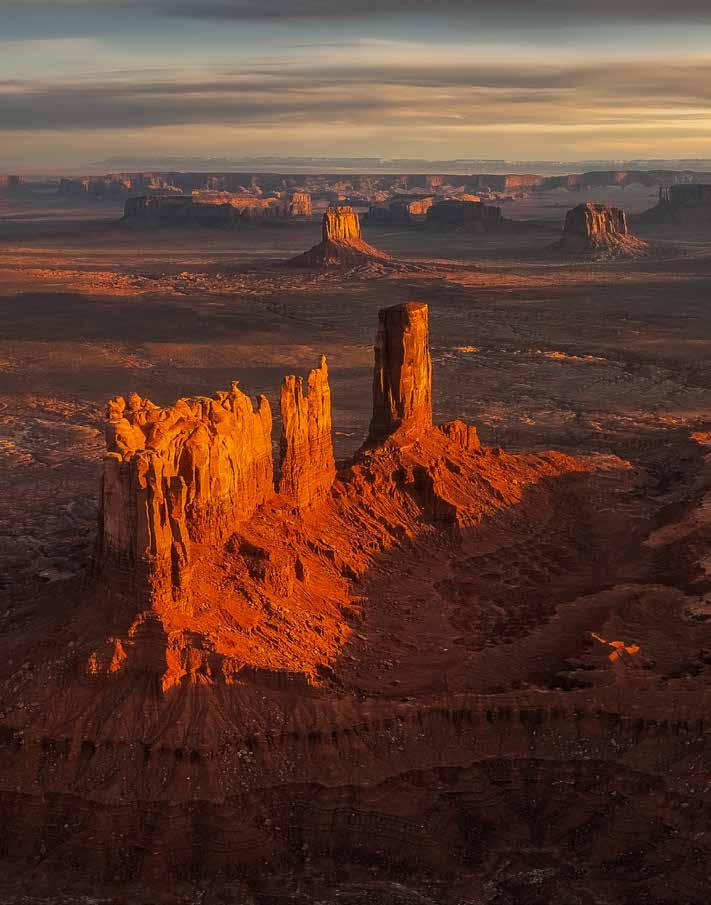
12 DESERET MAGAZINE OPENING SHOT
MONUMENT
VALLEY SUNSET
PHOTOGRAPHY BY AUSTIN PEDERSEN
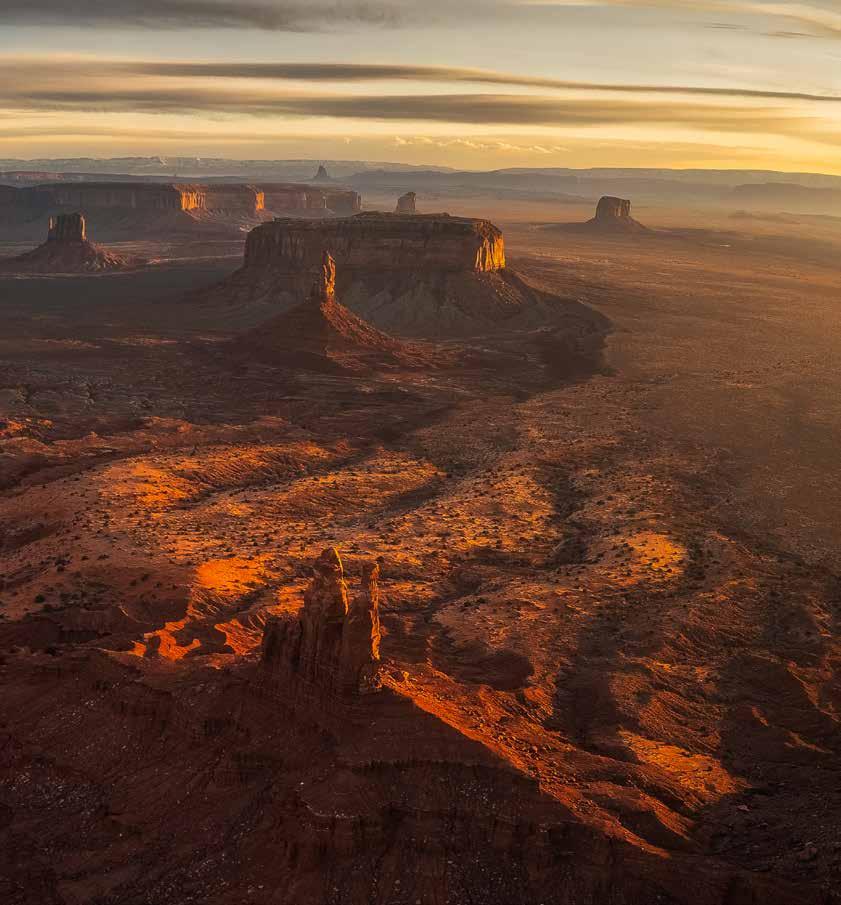
JUNE 2024 13

Won’t you be my neighbor?
Mister Rogers
FRIEND SHIP

THE OPEN ROAD
CONFESSIONS OF A BORN-AGAIN TRAVELER
BY ALAN J. HAWKINS
I’m a convert to the importance of vacations, a believer in how such special temporal zones can strengthen relationships and sweeten our days.
I was not always zealous about vacation time. My wife, Lisa, and I lived on a meager income for many years after we married, so perhaps our indifference to taking time off was rooted in necessity. And those early schooling, work and parenting years fully absorbed not just our means but our time and energy. Finding some fun and refreshment in our day-to-day prosaic life was a survival strategy. Short drives with the family through the gentle hills of central Pennsylvania to pick berries or cut down a Charlie Brown-ish pine tree for Christmas was about the best we could do. (Of note, research suggests that leisure and travel — that may take money away from necessities — may not have the same benefits for poorer families.)
Rare were those special family road trips that my former BYU colleague Susan Rugh wrote about in her delightful modern history of the American family vacation, “Are We There Yet?” In the post-World War II era, increasing middle-class incomes, big cars, new interstate highways, popular national parks and nuclear family values combined to produce a surge in family travel that captured the essence of an era (despite the children’s backseat bickering). The few road trips my family experienced usually had a clear utilitarian element, such as moving to a distant city for schooling or employment with a trailer in tow. Our five-day cross-country adventure from the Bay Area to central Pennsylvania for my doctoral
studies (with a brief stop in Chicago for our son’s emergency appendectomy) conjures up laughs and odd memories today. But it was anything but relaxing and refreshing.
It’s not that I was unaware of the importance of curating novel experiences and keeping the fun in relationships. I’m a relationship and marriage researcher and educator by trade. I teach this stuff! So, I sensed the risk in my casual commitment to couple and family vacation time.
Eventually, our economic fortunes improved. But by that time, our children were in their mid-teenage years with plans of their own. Our work and life demands didn’t fade; yet it got easier to attend to that gnawing need to call a timeout to the daily grind and take some real time off. So, in midlife, Lisa and I began to plan a couple of trips.
I trace my conversion to the personal and relational value of travel vacations to our first cruise — to Alaska. The stress-free days, gentle rocking motions of the ship, mesmerizing ocean waves, oxygen-saturated sea-level air, clouds-and-snow-covered summer peaks and humpback whales — we could feel the accumulated drudgery dissolving. And the stress-free time together somehow translated into more bonding talk — about meaningful experiences in the past and especially about our dreams and plans for the future.
Of course, it’s not just the relaxing and fun itself that buoys the spirit and sweetens the companionship. The anticipation put some sparkle in the days that preceded the trip and the memories of those times together are inextricably woven into our unique couple identity now; a part of who we are together is where we have been during those vacations. (The Norwegian fjords that awed us for a few days a decade ago are a continuing rich source of connection for us, facilitated by framed photos hanging on our walls.)
And in the Vrbo age, we have initiated biennial sibling reunions, usually close to some West Coast beach. I admit that I neglected sibling relationships during those busy family- and career-building decades. I did so knowing — again — the research on how valuable it is to maintain those connections. Sibling relationships are the longest family relationships we have and can be a vital source of support and meaning in our lives. And they testify to how we grow, change, forgive and forget in family relationships. That sibling fractious tension of the first two decades of life has morphed into sweet and rich friendship in the last few decades of life.
So, I’m a born-again believer now in the family or couple getaway. Personal experiences in later life have convinced me of the empirical accuracy of what I taught my students for decades. Family relationships are deepened and strengthened and blessed by special times away from our ordinary daily lives. With the summer travel season upon us, here’s to your family vacations in their many flavors, locations and seasons of life.
JUNE 2024 15 ILLUSTRATION BY KYLE HILTON COMMENTARY
ALAN J. HAWKINS IS MANAGER OF THE UTAH MARRIAGE COMMISSION AND AN EMERITUS PROFESSOR OF FAMILY LIFE AT BRIGHAM YOUNG UNIVERSITY.
WATER WORKS
DAMS BUILT THE WEST. SOME WANT THEM GONE

THE LARGEST DAM removal project to date is underway on the Klamath River, where it crosses the Oregon-California state line. There is little controversy that these four hydroelectric dams, built between 1908 and 1962 along a 35-mile stretch, have outlived their utility. But the empty reservoirs highlight a movement that is accelerating around the world. Eighty dams were decommissioned on American rivers in 2023, along with 487 in 15 countries across Europe. Here in the Western U.S., dams have shaped cities, economies and lifestyles for well over a century. Is it wise to tear them down? CLAY GRUBBS
16 DESERET MAGAZINE POINT / COUNTERPOINT
LET NATURE RUN ITS COURSE IF IT AIN’T BROKE
IT’S TIME TO rethink our relationship with rivers. Once we saw them as dangerous forces of nature to be conquered and controlled for maximum efficiency. But today, we understand the costs and impacts of those efforts, no matter how good the intention, from levees on the Mississippi to the Glen Canyon Dam on the Colorado. Many dams are simply outdated, silted up or at risk for collapse. In general, wild rivers foster healthier ecosystems and support human communities more effectively than waterways controlled by humans.
Rivers anchor complex biomes built on natural cycles like drought and flooding, which keep habitats vital and healthy for all manner of organisms, from aquatic plants to birds of prey and even people. Dams disrupt those cycles, and our attempts to replicate their benefits tend to fall short. Dams also lead to warmer waters, harming native fish species and breeding toxic algae. And of course, they limit breeding areas and block upstream spawning routes. Even the workarounds, ranging from “fish ladders” to “fish cannons,” can be harmful. Hundreds of thousands of juvenile salmon recently died on the Klamath due to gas bubble disease, caused by pressure changes in the water as they passed through a tunnel in the Iron Gate Dam.
More broadly, salmon populations are in peril throughout the Northwest, which keenly affects certain Indigenous groups who have lived along the rivers for ages but were largely overlooked by society when the dams were built. Many rely on native fish as a foundation for traditional lifestyles and even spirituality. Some have been displaced by reservoirs and new flood patterns, or impacted by attendant real estate development. “They’ve taken our land, they’ve taken our rivers, they’ve taken our fish,” said Carrie Sampson, elder of the Confederated Tribes of the Umatilla Indian Reservation, on the lower Snake River. “I don’t know what more they want.”
Traditionalists may well venerate dams as exemplars of American ingenuity and sacrifice, but many dams just don’t offer enough benefits to justify the costs of upkeep. On the lower Klamath, the price of fish ladders required by law was enough to push former owner PacifiCorp to favor removal. “We’re not ideological about it,” said Bob Gravely, spokesman for the energy company.
HUMAN BEINGS HAVE depended on dams for millennia. From the Middle East to China and the Rocky Mountains, we’ve used them to prevent flooding, irrigate arid land and store up water for the opposite of a rainy day. But they’ve shaped the American West to an extreme degree, allowing millions of people to inhabit homes in otherwise inhospitably arid desert environments. They should not be removed casually, ignoring the wisdom of our forefathers to appease special interests like the environmentalist lobby.
Grand structures like the Hoover Dam on the Colorado River — completed in 1935 and named one of the “Seven Modern Civil Engineering Wonders” — are monuments to human innovation that merit respect and preservation as part of American history. But they are also essential tools for ensuring that millions of people, from Phoenix to Los Angeles and Salt Lake City, have access to drinking water. Along with smaller dams throughout our river systems, they protect many towns from seasonal flooding and help us to grow crops or feed cattle. Ranches and farms often depend on reservoirs and canals to irrigate land and make rivers navigable, allowing them to efficiently and cost-effectively transport goods to coastal markets.
Hydroelectric power produced in dams also plays a vital role in providing energy across the West. For instance, five dams on the lower Snake River that are targeted for removal produce 12 percent of the electricity in the Federal Columbia River Power System in an average year, enough to power a city the size of Seattle. Existing plans to develop alternative sources would cost billions of dollars and likely raise annual rates by at least $100 per household.
Even if dams are not ideal, removing them risks unanticipated consequences. After the Klamath’s Copco Dam No. 1 was breached, fish and deer were found stranded and dying on the muddy riverbank, and nearby property owners worried about their wells, home foundations and flooding. On a larger scale, advocates for removal may be missing some of the implications of their desired policy. What happens when a dry year means there’s not enough water for the millions of people who live in Las Vegas? Around 21,000 men worked and sacrificed to build Hoover Dam. Maybe we should have a little more respect for what they accomplished.
JUNE 2024 17 ILLUSTRATION BY JACOB PLEITEZ
COLD COMFORT
WHEN IT COMES TO ICE CREAM, AMERICANS FIND A LOT TO LOVE
ICE CREAM IS synonymous with an American summer. When a familiar ditty plays over the tinny speakers of an ice-cream truck in any neighborhood, mouths of all ages begin to salivate. There are other foods we eat when it’s hot — like watermelon, hot dogs and tomatoes — but ice cream helps to keep us cool and sane. From modern gourmet flavors to the humblest grocery store brand, there’s no such thing as bad ice cream, especially if it’s fresh. Here’s why there’s so much to love.
JENNIFER GRAHAM

4 BILLION POUNDS
That’s how much ice cream Americans consume annually, amounting to more than 20 Nimitz aircraft carriers. That’s based on an estimate that the average American eats 12 pounds in a year — down from a whopping 16 pounds per person in 2000. Nearly three-quarters of us still report eating ice cream at least once a week.
Average yearly ice cream consumption per American:
16

SEPTEMBER 9, 1843
On that day, Philadelphia housewife Nancy Johnson obtained a patent for a device that would revolutionize the “art of producing artificial ices.” Her invention, the basis of today’s standard ice cream churns, improved on an age-old treat similar to snow ice cream. Roman emperor Nero sent slaves to the mountains to collect snow and ice to be mixed with fruit and honey. Other iced treats were created in China and other ancient civilizations.
18 DESERET MAGAZINE THE BREAKDOWN
pounds
pounds 2000 2024
12

4 INGREDIENTS
Thomas Jefferson’s recipe for ice cream — likely passed on by his French butler, found among 10 handwritten recipes in the third U.S. president’s personal papers — called for just two bottles of good cream, six egg yolks, a half-pound of sugar and a stick of vanilla. The process, however, was fairly complicated, including towel-straining and a fire. His successor’s wife, Dolley Madison, had more exotic tastes, with a predilection for oyster ice cream.

That’s when a man named Harry Burt of Youngstown, Ohio, first sold ice cream from a truck. The food’s popularity surged during Prohibition, as adults who could no longer drink alcohol legally turned instead to sweets. Burt also founded the Good Humor brand, known for his novelty “ice cream on a stick” and salesmen who tipped their hat to women and saluted men.
$100 A WEEK
By 1932, Good Humor drivers were earning that much each week, more than $1,800 when adjusted for inflation. While the tell-tale jingle may feel less common now, business is thriving. One company in Massachusetts said its drivers make $20-$30 an hour, plus tips — plus a signing bonus. And in a new twist, certain ice-cream truck drivers in New Jersey will show up at your door if you text them.
“We simply don’t have enough good-quality evidence to suggest that ice cream definitely has any health benefits. But a couple of small portions a week — paired with an otherwise healthy diet and exercise regime — is unlikely to do much harm.”
DUANE MELLOR, ASTON UNIVERSITY

Orders shipped from Jeni’s Ice Creams of Columbus, Ohio, arrive sci-fi cold, thanks to dry ice. Competitors from specialty shops to large retailers like Harry and David’s also ship anywhere in the U.S. In recent decades, weird science has also gifted us with “beaded” ice cream like Dippin’ Dots and nitrogen ice cream from a Utah-based chain called Sub Zero.
31 FLAVORS
That’s the threshold for a product to qualify as ice cream, according to the federal government, in a mixture of dairy, sweetening and flavors that must weigh 4.5 pounds to the gallon. Vegan ice cream is out. So are soft-serve cones and other fast-food frozen dairy treats. And while most brands at the supermarket qualify, many are also ultra-processed foods, linked to signs of addiction in a recent study by the University of Michigan.
The old Baskin-Robbins moniker sounds quaint in a world with ice creams that taste like mac and cheese, dill pickles, lobster and Thanksgiving dinner. Polling shows New York still prefers pistachio; South Dakota loves birthday cake; and Oregonians favor green tea. For Utahns, nothing tops rocky road — chocolate ice cream with nuts and marshmallows — which was adventurous for the 1920s, when two companies in Oakland, California, claim to have invented it. The author prefers the taste of frozen custard, though it’s not even ice cream.
4.5 pounds
Dairy, sweetening and flavor mixture must weigh to the gallon.

JUNE 2024 19
1920
-109.3°F
10% MILKFAT
ILLUSTRATION BY BRENNA VATERLAUS
THE DELICATE ART OF DOING NOTHING
PARENTS DREAD SUMMER BOREDOM. WHY THEY SHOULDN’T
BY MEGAN FELDMAN BETTENCOURT
On the morning of my daughter’s fifth birthday party, I made a cheese tray for parents and set out craft projects for kids before anxiously writing a run-of-show at my kitchen counter. My husband, having plucked the last of the dirty laundry off the floor, sidled up next to me and raised his eyebrows. “What are you doing?” he asked.
“What does it look like?” I snapped, glancing at the clock. “I’m making an agenda!” This was the first party we had hosted since before the pandemic. Every recent birthday party we were invited to was held at an overpriced (and overstimulating) location built to entertain. A giant trampoline park. A labyrinthine ropes course. Chuck E. Cheese. What on Earth would we do with 10 kids and a dozen parents in our unremarkable suburban home?
My husband was quiet for a moment. He was choosing his words carefully. “Don’t
you think we could let it evolve organically?”
“But what if they’re bored?” I was horrified at just the thought of parents milling about the house, awkwardly picking lint off their sweaters and checking their phones.
IT TURNS OUT THAT BOREDOM IS IMPORTANT FOR STIMULATING CREATIVITY AND PROBLEM-SOLVING, AS WELL AS FOR GIVING OUR BUSY BRAINS SOME MUCHNEEDED REST.
And what about the kids, who were used to inflatable slides and loud video games — would they be bored, too?
As I looked at my husband, I saw myself through his eyes: a mom so insistent on
warding off boredom that I was applying the agenda-writing skills I used at work to a kindergarten birthday party. The first guests knocked on the door.
I hoped everyone would have a good time. But above all, I feared they would be what has somehow become one of the worst things in our frenetic society, built around accomplishment, and “life hacks,” and optimizing every minute: bored.
MOST PEOPLE, KIDS and adults alike, find boredom uncomfortable and strive to avoid it. Especially now, as summer begins, parents like me are scrambling to fill our children’s calendars. This preference for being occupied and entertained has grown with the advent of technologies that enable us to do routine tasks faster and remain constantly connected. If we’re not working outside the home, doing house chores or talking on the phone while driving, we
20 DESERET MAGAZINE MODERN FAMILY

MANY OF US DESIGN OUR CHILDREN’S LIVES IN WAYS THAT MINIMIZE THEIR OPPORTUNITIES FOR BOREDOM AND THE CRUCIAL DEVELOPMENT THAT COMES WITH IT.
are scrolling Instagram, devouring digital news or coaching youth soccer. Kids are busier than ever, too, engaged in long days of school, extracurriculars, homework and social media.
The casualties of this harried state of constant activity are rest, relaxation, hobbies, unstructured time, in-person social connection and even boredom itself. The effects on our mental health are alarming. American workers are reporting record-breaking rates of burnout and stress, while skyrocketing rates of depression, anxiety and suicidality in kids have prompted children’s hospitals to declare a national state of emergency for youth mental health. It turns out that boredom is important for stimulating creativity and problem-solving, as well as for giving our busy brains some much-needed rest. When we notice the stillness or disinterest that most of us characterize as boredom, responding in constructive ways pays dividends in productivity, creativity, social connection and mental wellness.
So if boredom really is good for us, then how can we learn to incorporate it into our lives despite the constant pressure to avoid it?
In psychiatric literature, boredom is defined as a state of mind featuring disinterest or lack of stimulation or challenge. Ironic, since being bored these days is a challenge itself. Boredom often arises from repetitive tasks or a lack of novelty, and can make us feel restless. We ideally learn to tolerate and productively manage that restlessness, starting in childhood. Being bored prompts kids to make up imaginary games, initiate play with other children and take a proactive role in their own activities. This builds creativity and problem-solving skills, as well as social acumen, resilience, independence, initiative and self-esteem.
Yet many of us design our children’s lives in ways that minimize their opportunities for boredom and the crucial development that comes with it. We make sure their calendars look like that of a full-time working adult. Cringing at the whiny refrain, “I’m
bored!” we orchestrate a game or allow hours of screen time so we can get things done or enjoy a break, all the while robbing them of the chance to develop positive coping skills.
Unfortunately, over the past 60 years, American children have spent less and less time engaged in self-directed play with each other and more and more time in adult-led activities that leave little time for being bored or conducting their freestyle type of play (child development experts define play as an activity a child chooses to do, rather than is obliged to do, and which involves imagination, scant or no adult interference and a focus on means more than ends). Psychologists connect this decline to rising anxiety and depression in children and teenagers. The link makes sense, as anxiety, in particular, is directly linked to feeling a lack of control over one’s life.
Technology is also a societal shift that has robbed children of the chance to be bored. Psychologists point out that the rise of pediatric anxiety, depression and suicide that began in 2005 and skyrocketed starting in 2012 mirrors the rise of smartphones and social media. Constant social media scrolling comes with overwhelming information bombardment and a lack of rest, stillness, unstructured time and boredom.
A consequence of depriving kids of the freedom to be bored is that when the restless feeling does arise, they lack coping skills and are more likely to respond with risky behavior such as dangerous thrill-seeking or substance abuse. There’s a reason that evidence-based therapy for a range of pediatric mental health conditions, from anxiety and depression to aggression, focuses on one key skill: the ability to notice, embrace, process and navigate difficult emotions. Take, for instance, boredom. The better kids and adults alike become at doing so, the more resilient we are.
As we become adults, our need for boredom becomes a need for unstructured, independent and self-chosen activities that allow us to engage with the present moment instead of a future goal. This could
22 DESERET MAGAZINE MODERN FAMILY
be taking a stroll or engaging in a beloved hobby or spending time practicing your faith or meditating or literally “doing nothing.” In “Niksen: Embracing the Dutch Art of Doing Nothing,” author Olga Mecking defines “niksen” as doing nothing without a purpose. Italians, meanwhile, prize “il dolce far niente,” the sweetness of doing nothing. If all this sounds similar to Buddhist principles of being present in the moment and practicing mindfulness meditation (sitting and breathing while noticing your thoughts and bodily sensations), that’s because it is. The common focus is on being (in the moment) as opposed to doing (to reach a future goal).
Counterintuitive as it may seem, making time to do less recharges our brain, restores our mood and brings heightened powers of critical thinking and strokes of insight. Albert Einstein reportedly spent a lot of time away from friends, family and work to do nothing but think, and some of his best ideas came while walking, sailing or playing his violin alone. Most of us have had the “epiphany in the shower” experience, when a mundane activity like bathing brings creative solutions, seemingly out of nowhere. For me, this happens during my daily walks, when I often have so many ideas that I need to dictate them into my phone.
BEING FOCUSED ON the present moment without a care for “getting things done” is not a natural setting for most Americans. The Puritan belief that “an idle mind is the devil’s workshop” still influences many of us, while our culture’s celebration of celebrity has conflated happiness with the materialistic push for more, bigger and better.
Then there’s the issue of free time. For decades, the average American’s buying power has evaporated while wealth has concentrated in the top tier of the economy. Prices for basic necessities have surged. In my grandparents’ day, a police officer or teacher could buy a home and support a family with one salary. Now, households with two toiling earners are barely covering basic expenses, much less saving for retirement. Overwhelmed
working parents are less likely these days to have parenting support and need help with child care.
In this context, the suggestion to make time for boredom may seem unrealistic and even insensitive. Yet what if our lives depend on it? Stress can negatively affect our heart health, mood health and immune function, and Americans are more stressed than ever. According to a 2023 American Psychological Association survey, 77 percent of U.S. workers reported stress at work last year, with 57 percent reporting negative health effects as a result. Workplace burnout — linked to stress, anxiety and depression — has also reached record highs. At least 55 percent say they
COUNTERINTUITIVE AS IT MAY SEEM, MAKING TIME TO DO LESS RECHARGES OUR BRAIN, RESTORES OUR MOOD AND BRINGS HEIGHTENED POWERS OF CRITICAL THINKING AND STROKES OF INSIGHT.
can’t establish a work-life balance, and employees with the least financial security are most likely to be burned out, according to a Workforce.com report.
Though it might seem like we need a month of doing nothing on the beach to recover, one way to incorporate stillness into our schedules is with micro-moments. As a type-A parent who works outside the home, I try to do a five-minute meditation each morning between getting my kids off to school and diving into my inbox. I sit quietly and focus on my breath until my timer goes off. On days when I manage to do this, I feel calmer and more awake. Moments of nothingness don’t have to be meditation, though. I have a colleague who schedules daily dog
walks and lunch breaks, and another who grows chrysanthemums.
Another way to be “in the moment” is to use the concept of niksen and do what we’re already doing without multitasking or striving for a goal. It could be focusing only on our food while eating, for instance, or admiring the sights and sounds of the forest while hiking instead of talking or tracking our steps. On a recent drive through the Colorado plains, I resisted the urge to return phone calls or listen to the news. Instead, I rolled down the windows and blasted Tom Petty. When I arrived at my destination, I felt refreshed.
Infusing days with less doing and more being takes intention and discipline, like any habit. It takes standing firm against the cultural current that drifts ever toward exponential busyness. My resistance to stillness is not so different from my children’s cries of, “I’m bored!” In both cases, pushing through the resistance is worth it.
One recent afternoon, my nine-year-old son spent 10 minutes demanding more Nintendo time after his allotted hour was up and the tablet automatically shut off. I denied him and continued to work on my laptop. He walked away, dejectedly muttering something about being “so bored.” An hour later, he reappeared, proudly displaying a wooden walking stick that he had whittled outside. Other bouts of boredom have yielded blanket forts, elaborate dinosaur action displays and a catapult made of a cardboard box, plastic spoon and rubber band. Often, he and his sister collaborate on these projects or play “keepy uppy,” which involves keeping a balloon in the air for as long as possible.
This summer, during weeks when my son is not at camp but his father and I are working, I plan to use blocks of unstructured time during which he gets to choose what he does outside, which project to start, which book to read. Maybe structuring unstructured time is kind of an oxymoron and not exactly doing “nothing,” but it’s as close as I can get as a working parent. In a fast-paced world, more nothing is better than no nothing at all.
JUNE 2024 23
SPACE FOR SALE
WHAT’S THE FUTURE OF THE FINAL FRONTIER?
BY REBECCA SOHN
On February 22, 2024, the Odysseus spacecraft touched down on the moon. It was the first American spacecraft to land on the lunar surface in over 50 years, and, like its predecessors, it carried gear for NASA experiments. But it wasn’t owned by NASA. Instead, it was the product of space exploration company Intuitive Machines, making it the first spacecraft manufactured by a private company to land on the moon.
Intuitive Machines, based in Houston, Texas, might seem like just another player in the seemingly crowded — and growing — private space industry. Companies like SpaceX and Blue Origin, who, like Intuitive Machines, work with NASA to bring astronauts and equipment to space, are also committed to commercial spaceflight, already giving select private citizens a ride into space. Meanwhile, companies like AstroForge are attempting to make extraterrestrial mining a reality. Increasingly, these companies are the ones who own the
spacecraft being launched into the galaxy. While each is jockeying for position in the burgeoning market that space is becoming, their earthly establishment is largely based in the American West — a place that, not too long ago, to many people across the globe, felt something like space. A place
WITH SO MANY CURRENTLY EYEING THE COSMOS, IS SPACE THE NEXT FRONTIER IN PRIVATE DEVELOPMENT?
to be explored, “discovered,” mined, tamed and claimed. A place that could make a person rich. And, ironically, a place that, in the beginning of white settlements, only well-to-do people could access. However, this time, instead of gold and land, the
pioneers of space have their sights set on technological advancement and, well, actual space. With so many currently eyeing the cosmos, is space the next frontier in private development?
The ambiguity of the answer lies largely in the murkiness of the ownership — or lack thereof — of space. Questions about ownership in outer space might have previously existed only in science fiction, but took on new importance during the space race that raged after the West’s well-known chapter of early atomic development in New Mexico and during the Cold War between the United States and the Soviet Union, according to science and technology historian Teasel Muir-Harmony. “A lot of these early laws were driven by a fear of nuclear weapons,” says Muir-Harmony, the curator of the Apollo Collection at the Smithsonian National Air and Space Museum. “But they also dealt with questions of ownership.”
Unlike the plains, mountain ranges, deserts and rivers that unfolded before white
24 DESERET MAGAZINE
NATIONAL AFFAIRS
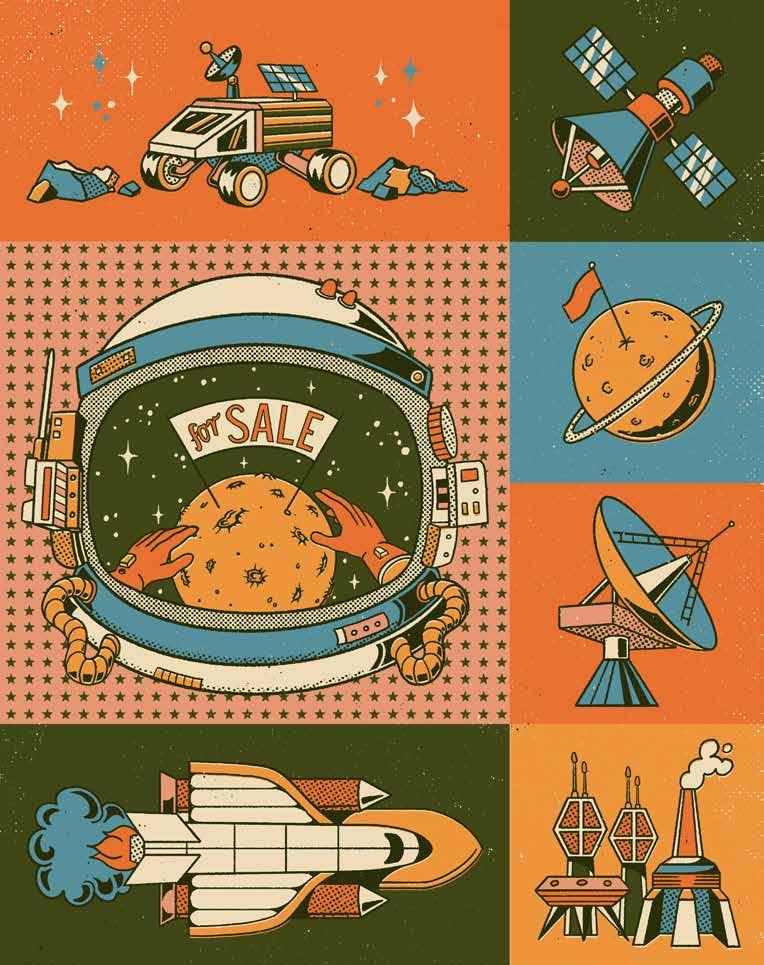
JUNE 2024 25 ILLUSTRATION BY PHILIPP BECK
settlers as they pushed west, ownership isn’t something that’s able to be claimed in space as of now, due to specific laws outlined in the Treaty on Principles Governing the Activities of States in the Exploration and Use of Outer Space, including the Moon and Other Celestial Bodies. Commonly called the Outer Space Treaty of 1967, it became the central international pact of space law. Regarding ownership, the language is clear: No one can truly own outer space.
The treaty emphasizes that “no one can claim the territory of the moon or other celestial bodies,” says Muir-Harmony, nor any other part of outer space, including Earth’s orbit. Though the treaty technically only says nations can’t claim sovereignty over space, a country wouldn’t have the authority to let a private company own part of outer space without some kind of claim of ownership themselves, which would violate the treaty. The United States, the Soviet Union and the United Kingdom were among the first countries to sign the treaty, and today, 114 countries have signed and now observe the laws it outlines.
It’s worth noting that the lack of any ownership created by the Outer Space Treaty has caused its own problems. For instance, the treaty says nothing about regulating waste in space, and without any country owning space, no one is responsible for keeping it clean, writes Chris Impey, a professor of astronomy at the University of Arizona. There are over 9,000 satellites and 23,000 pieces of debris in Earth’s orbit alone. That’s not even counting the nearly 100 bags of human waste, 200 tons of trash and the remains of over 50 crashed rockets that litter the surface of the moon.
More than a decade later, the Agreement Governing the Activities of States on the Moon and Other Celestial Bodies, usually called the Moon Treaty, emerged in 1979. It outlines more regulations around exploring and taking resources from planetary bodies. But unlike the Outer Space Treaty, not a single nation with an active space program signed and passed corresponding laws that would enforce the treaty. “There
was concern in the U.S., especially voiced by many space advocates at the time, that agreeing to the moon agreement would discourage investment of private industry in space and inhibit future exploration,” says Muir-Harmony. Since then, how people will choose to preserve space — or not — has been up for debate.
IN DECEMBER 2023, the Biden administration proposed a new framework to Congress to regulate these businesses called the Novel Space Activities Authorization and Supervision Framework. The framework is a first step in regulating what private companies might launch into space: for instance, spacecraft for asteroid mining or space tourism. The secretaries of
NOT EVERYONE AGREES THAT WE SHOULD BE CONCERNED ABOUT EXPORTING ALL OUR EARTHLY PROBLEMS WITH OWNERSHIP INTO THE COSMOS. NOT FOR A LACK OF PRECEDENCE HERE, BUT FOR A LACK OF POSSIBILITY OUT THERE.
the departments of Commerce and Transportation would share responsibility for authorizing and supervising new uses of space, though the framework also creates an interagency group that would work with industry to discuss how future endeavors in space might be regulated. The administration also submitted draft legislation to give the departments this new regulating power in November 2023. But Congress hasn’t passed it, and many industry groups object because of what they see as too much government oversight. It’s unclear if or when it might take effect. Without this kind of future regulation, it might seem strange that countries can control what goes on in space at all — in fact, that regulation might seem similar to a
kind of ownership. Having the right to use a space, especially exclusively, is another key concept in how people imagine ownership.
“One of the general ideas about ownership is that you can exclude other people,” says Steve Mirmina, an adjunct professor of space law at Georgetown University Law School. Because no one can own space, current law wouldn’t allow, for instance, an asteroid mining company to prevent another company from mining the same area. But in the interest of safe use, it’s possible that in the long term, policies may change and allow some exclusive access to a part of space — for instance, groups doing research or mining in a certain area.
Many people have raised questions about the extraction of resources in space before — in fact, they were the subject of the Moon Treaty, says Muir-Harmony. That the United States and other countries never signed on left the subject, largely theoretical at the time, unresolved. Consequently, situations the treaty might have applied to have remained legally ambiguous. For instance, it has been unclear who legally owns the over 800 pounds of lunar samples brought back to Earth from the Apollo missions. At the time they were brought to Earth, no law governed the use of resources from space, and the Outer Space Treaty does not lay out any guidelines for who owns materials brought to Earth from outer space. Still, the United States has always acted as if it owns them.
It’s only recently we’ve begun to revisit these issues. In 2015, the U.S. passed the Commercial Space Launch Competitiveness Act, which allows U.S. companies and citizens to own resources from space. The act was immediately controversial, with some arguing that it violates the Outer Space Treaty by allowing the ownership of a part of space. There’s also the question of how to interpret the law: When might something count as territory versus resources? “I don’t actually know how that gets resolved,” says Matthew Weinzierl, a professor at Harvard Business School who has done research on the economics of the
26 DESERET MAGAZINE
NATIONAL AFFAIRS
space industry. Interpretations as simple as this are capable of showing the cracks. It’s unclear how companies like SpaceX, Blue Origin and extraterrestrial mining operations like AstroForge see their role in future space presence and treaty agreements. Deseret Magazine reached out to these companies but did not receive a response from SpaceX, while both Blue Origin and AstroForge declined to comment.
NASA’s upcoming return to the moon as part of its Artemis missions has also prompted the drafting of a set of nonbinding international agreements called the Artemis Accords. The accords reiterate the 2015 law and set up so-called “safety zones” for exclusive study or resource extraction on the moon and other celestial bodies. Like with the 2015 act, those opposed characterize the Artemis Accords as allowing private ownership of celestial bodies in all but name if companies are “saying that (they) can use this area and no one else can,” says Brendan Rosseau, a researcher at Harvard Business School who works with Weinzierl. Despite objections, 39 countries have so far signed the agreement. Still, neither Russia nor China has signed on, highlighting the continued disagreement between people and nations about how we should explore, utilize or even own outer space, says Muir-Harmony.
But really — could we actually mine space? Are companies going to run non- NASA -funded moon missions or launch space hotels? Is space a “frontier” at all? Is all of this discussion even worth it?
NOT EVERYONE AGREES that the world needs new regulations on things like mining in
REGARDING OWNERSHIP, THE LANGUAGE IS CLEAR: NO ONE CAN TRULY OWN OUTER SPACE.
space, or that we should be concerned about humans exporting all our earthly problems with ownership into the cosmos. Not for a lack of precedence here, but for a lack of possibility out there. “I think these claims about resource utilization are greatly exaggerated,” says space historian Dwayne Day. With companies focused on asteroid mining, such as Planetary Resources and Deep Space Industries, having already failed or pivoted to developing other technologies, he also doesn’t see these companies as realistic ventures. From his perspective, claiming land in space would be as meaningful as claiming a remote stretch of ocean without the ability to defend it, regulate it or extract resources from it. Aside from mining rare minerals like platinum, even mining lunar ice, which some suggest could be converted into rocket fuel, would require a vast and unfeasible amount of energy.
Still, these conversations have been a long time coming and are far from resolved. In fact, many of the concerns that sparked the creation of the Moon Treaty were raised by countries that had suffered under colonial rule. “A lot of those advocates for the Moon Treaty were coming from the Global South … and had direct experience with the exploitation of mineral resources in their own home countries,” says Muir-Harmony. The treaty was originally signed by seven countries — Austria, Chile, France, Guatemala, Morocco, the Philippines and Romania. Today, only 18 countries have fully adopted it. “Conversations about the moon and how humans should explore the moon are really closely aligned to these debates about the power structures that have occurred on Earth and whether or not those should be
exported to the moon and other celestial bodies,” adds Muir-Harmony.
While the Artemis Accords don’t mention the Moon Treaty, they also don’t propose any change from the Outer Space Treaty regarding strict international regulation around commercial activity or resource extraction. In an executive order accompanying the U.S. signing of the Accords in 2020, former President Donald Trump called the Moon Treaty “a failed attempt at constraining free enterprise.”
Weinzierl believes that exporting our problems into space is a danger, from unequal access to resources to power struggles between nations. But in some ways, it would be better if there were true property rights in space. “If you don’t have some sort of private property rights, it’s really hard to incentivize the development of markets,” he says. Not regulating a market like this could spark more problems, such as unequal access to resources. These resources might include minerals, water and gases, but also access to the cosmic matter these resources are extracted from.
Still, all of that can seem a long way away. As of February, the world’s first privately owned moon lander has been officially declared inactive after it tipped over upon landing. SpaceX and Blue Origin haven’t carried passengers to the moon or Mars, and asteroid mining companies haven’t brought back any resources. For now, space still belongs to everyone and no one, and buying up what it has to offer, whether that’s a right to study it or owning resources taken from it, will remain mostly relegated to the realm of science fiction.
Unless, of course, it becomes real.
JUNE 2024 27
GLORY TO THE GRAND
WHY THE CALL OF THE WILD PERSISTS
BY HEATHER HANSMAN
Eight miles into the Grand Canyon, legs flung over the front tube of the raft, I was still dry, gaping at the way 40 million years of geologic history have compressed into a few thousand feet. Watching the sky shrink as the walls got higher, I was lulled into a kind of complacency by the heat and the river’s rhythm. Then came the drop into the edge of Badger Creek Rapid. A wall of water washed over the front of the boat, stopping us, soaking us and spitting us out. A river can change your mind pretty fast.
I’ve been a river runner since I was an 18-year-old rookie raft guide, stringy-armed and reedy-voiced. In a boat, I learned that rivers give you power, but only once you find the line between holding your angle and falling into the flow — an act easier said than done. Moving downstream lets you feel connected to everything around you. That’s a feeling I’ve been chasing ever since, numinous and hard to name.
I am 40 now, and sometimes I feel far from the person who went to the river that first time, ready to dive into the unknown. Now, I have a mortgage and a garden. I have achy, stitched-together joints, and I
sit in front of a computer most days. My life feels too soft, too superficial, too fast and smooth. I’d been missing that edge and missing the river.
So I signed up to be a swamper, a glorified intern on a commercial trip, working for free because I’d given myself the idea that the best place to re-immerse myself
MY LIFE FEELS TOO SOFT, TOO SUPERFICIAL, TOO FAST AND SMOOTH. I’D BEEN MISSING THAT EDGE AND MISSING THE RIVER.
was here, in the Grand Canyon, the pinnacle of American river trips. I wanted to see if I could still be the girl who would throw herself into the waves, watching the bubble line for clues. I wanted to remember why it felt so good, and I’d decided this was the place. That first splash brought me back.
If you were just to look at geographic stats, the Grand Canyon might not seem that grand. It’s not the biggest canyon in the world, nor the deepest or the longest. It’s not even the biggest canyon in its own basin; Desolation Canyon upstream is deeper. But here, the razor blade of the river cuts through a billion-year history of rock, revealing all of our existence and more.
Humans have used the Grand Canyon for 13,000 years, since the last ice age, and the river flows through the region’s cultural history. “Our ancestors had always told us not to forget that the middle of the river is the backbone of the people,” Hualapai tribal member Loretta Jackson-Kelly told the Grand Canyon Trust. “Without the backbone, we cannot survive.” Hualapai say the native fish in the river are their ancestors; everyone says that the water is life.
Hopi say that a boy named Tiyo, who was searching to understand the river, was the first person to travel down the San Juan and Colorado rivers, into the Sea of Cortez. He returned with the story of the rain dance and helped break a long drought. Colonial Western history pegs the first
28 DESERET MAGAZINE THE WEST

JUNE 2024 29 ILLUSTRATION BY GREG NEWBOLD
successful trip through the Grand Canyon as the Powell Geographic Expedition of 1869. Before Maj. John Wesley Powell led a group of nine men down the Green and Colorado rivers, recording the geology and geography along the way, the canyon was the last great unmapped section of the country. From their perspective, no one had ever made it through alive before. Powell lost three men along the way, but he made it back with maps.
Whichever story you hold true, the common ground is that there weren’t many people floating the river before the middle of the 1800s, and it took another 100 years for anyone to do it with any regularity. The Colorado River through the Grand Canyon was epic, dangerous, beautiful.
It became a touchstone for why we go to wild, adventurous places, and the harms we enact when we do. The curve of recreation in the country is mapped out here, from exploration to attempted extraction to a rush of adventure.
But even with that focus on action, Nikki Cooley, the first-ever Navajo river guide, says we can’t think of it like a theme park. The river, which is dammed above and below the canyon, is a fragile, frangible place: It’s in a national park, heralded as pristine wilderness. But it’s also severed by those dams, threatened by mining and drought — hoisting a patchwork of adaptive management plans and the misplaced good intentions of past lives up between it all. The river is the backbone of so much, and rafting is a way through.
ON THE WATER, days become ritualistic: the hours on the water, the thunk of oars, the Zen work of unpacking and repacking your home every day on a different slanted beach. Morning stretching, afternoon hikes up side canyons, evening drinks, the way we all grip tight when the rapids ramp up. The river moves in an S-curve south and west. Every night we are deeper in. Every day I see something I didn’t even know to look for.
The only other time I’ve been here in the gut of the gorge, I was running rim to
rim to rim, down to the river, back up, then reverse. On the trails down from the rim, you cut a quick line through all the layers, feeling yourself drop down through time, and then pulling yourself back up. Now I’m moving on the other axis, through instead of across.
In a boat, you move at the pace the river sets, the canyon unspooling in front of you, layer by layer, changing color and pitch. In the slow water days, like when we float through Furnace Flats, time compresses, and I have time to read about the people who came through before me.
The first women to successfully make it through the canyon weren’t looking for thrills or isolation; they were looking for plants. Lois Jotter and Elzada Clover, two
botanists from the University of Michigan, were trying to record unknown species. Clover had met Norm Nevills, an early river guide, on a previous research trip. Nevills, who had been running other rivers in the basin, had never seen the Grand Canyon before, but he wanted to, and he wanted attention for it, so together they hatched a plan to paddle through. Their trip became a precedent for the future: in the way they ran the river, in the biological record they captured, in the fact that women could handle the canyon — an idea that had previously been dismissed. Journalist Melissa Sevigny, who recently wrote a book about their groundbreaking trip, “Brave the Wild River,” said the two were surprised by how powerful the river was, but they were also
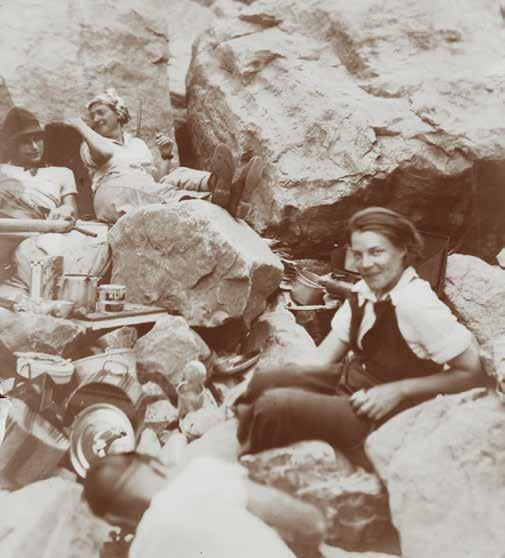
30 DESERET MAGAZINE THE WEST
CLINE LIBRARY, NORTHERN ARIZONA UNIVERSITY
shocked by its beauty and range. They thought the river might be “barren and hellish,” but instead, they cataloged 400 species of plants. “Clover wrote about how she’d been told the canyon was this dark, gloomy place,” Sevigny told me. “I think she fully expected to experience that, but found it not to be the case — she formed a very deep connection with the canyon and the river and wrote eloquently of its beauty.”
The trip changed their perception of the place, and their perceptions of themselves. Years later, Jotter — who, among other feats, spent a night stranded alone on a high water beach — would still talk about the boost of confidence that came from facing the river, and her own capabilities in the face of it.
I am a little jealous of that trip, and of how much was unknown when they set off. In some ways, that feels far away right now, when nearly everywhere is mapped, geotagged, Google-able. But you can never really know a rugged place, or know how you’ll respond, until you’re in it, shoulders and hands hardening, a form of personal erosion. To learn what Jotter did, I think you have to feel the friction in your body. By the end of the first week, I have heat rash and Velcro fingertips. New muscle deep in my elbows aches from rowing, and layers of my skin slough off, exfoliated by the spackle of sunscreen and sand. Sometimes the wind blows so hard that we’re basically floating backward. We carry on, somewhere between uncomfortable and entranced.
When we spend a night at Big Dune Camp, the river, which had been clear and greenish from dam runoff, turns red from flash flooding. It runs thick, the color of terra cotta. It’s how the river would have been before the dam went in and held back all the sediment behind its walls.
Sand is the story of how the dam stops time, changes the ecosystem, strips it bare. Even this camp is a remnant of the unnatural balance struck between these walls.
Last spring, after a big winter of snow, the Bureau of Reclamation decided to conduct what it calls a high flow experiment.

The bureau sent a big pulse of water out of Glen Canyon Dam, intending to mimic historic high flows. That water ripped through the canyon, flushing out debris, setting off native fish spawning cycles, and rebuilding beaches, including the eponymous big dune here. It’s been destroyed and poorly rebuilt by hydraulic engineering, as has so much else in this protected canyon we hold up as the highest level of wilderness. It’s one thing to know that, intellectually. It’s another to see it happen. When you’re outside in a landscape where you can feel the erosion and see the river change, you’re forced to confront it. Contact leads to understanding and incentive to take care of the place. It makes it real. The grit makes the good parts shine.
One midmorning, we hike into a waterfall up clear blue Shinumo Creek. We dive under the spray, swimming into the cool green cave behind the falls, rinsing the grit out of our hair and our eyes. Tiny threatened native humpback chub tickle our toes. They have a stronghold here. It seems like every side canyon holds a secret or a story like that. I think you could come through a
SINCE 1996, RELEASES FROM GLEN CANYON DAM (PICTURED) INTO THE GRAND CANYON HAVE GENERALLY RANGED FROM 8,000 TO 25,000 CUBIC FEET PER SECOND, CONSTANTLY CHANGING THE FLOW AND CONDITIONS OF THE COLORADO RIVER.
OPPOSITE: LOIS JOTTER AND ELZADA CLOVER, TWO BOTANISTS FROM THE UNIVERSITY OF MICHIGAN, WERE THE FIRST RECORDED WOMEN TO HAVE PADDLED THE COLORADO RIVER THROUGH THE GRAND CANYON.
JUNE 2024 31
GETTY IMAGES / JEFF TOPPING
million times and still keep stumbling on newness. It’s not just the rapids and the big water rush that make it magic, like I had thought it might. Instead, it comes from the details and from having the time to let them sink in.
PSYCHOLOGICAL RESEARCH HAS found that feeling small and independent in a big place is good for our brains. A 2018 study from UC Berkeley found that awe, more than any other positive sensation, gives us a full spectrum sense of well-being, which can help people recover from PTSD, anxiety and a wash of other stressors. The Berkeley researchers monitored the stress hormones of veterans and at-risk teens who spent time outside and found that stress hormones significantly lowered when they were on river trips.
The awe sneaks up on you. It’s the weight of the oar in my hand and how I learned the river by figuring out the feeling of water on a blade. It’s how I now know what bighorn sheep look like silhouetted on the ridge, the ram in full curl. And how I know what happens when you follow the track of a tiny scorpion and find it under a rock, translucent and mad. It’s that balance of working hard and letting go. Meeting the river and letting it move you.

Once you get addicted to that alchemy, you are never far from the canyon in your mind. There will be rapids running through your dreams, cutting through tapeats and travertine. Some people get it so bad that they’re always trying to get back, unable to let go, sucked into the mythology and the movement.
“OUR ANCESTORS HAD ALWAYS TOLD US NOT TO FORGET THAT THE MIDDLE OF THE RIVER IS THE BACKBONE OF THE PEOPLE. WITHOUT THE BACKBONE, WE CANNOT SURVIVE.”
People and their stories stipple the myths. Nels Niemi, who died in October, rowed it 178 times, starting in 1967. In the days before the National Park Service started regulating trip length, he spent over 100 days straight on the river, connecting the Snake, the Green and the Colorado, making a home of the canyon. He’d been down there so much he knew exactly where to find sun in December.
Seth Mason, a member of the U.S. men’s rafting team who made several attempts to set the speed record through the canyon, says the team spent obsessive years training, trying to memorize every rapid so they could run it in the dark. “For us, the pull had a lot to do with the lore and this rich history of people chasing crazy ideas down there,” he told me.
They didn’t break the record. One time, the flows weren’t high enough. On another attempt, they busted up their boat at Lava Falls, mile 179 of 277, trying to run through the gnash of whitewater in the dark. A reminder that the river is in charge.
The rapids aren’t necessarily the best part of the river, but they keep you honest. All trip, I had an underlying stomach churn about the biggest rapids: Crystal and Lava
Falls, wondering how they would go. Lava is the last big rapid and it looms over everything. There’s an adage in the Grand Canyon that you’re always above Lava, even off the river.
I’d been worrying, and then suddenly we were above it. Standing at the scout for the rapid, watching the water pile up over the thundering ledge hole at the top, funnel down toward the Big Kahuna wave and slam the Cheese Grater rock on the right. Some of the famous rapids in the Grand aren’t tricky, they’re just big, but Lava is both technically difficult and huge. It’s the epitome of the river’s power. You can feel the force from shore. And you have to make it through Lava to make it through the canyon.
We ran left at Lava, hitting the edge of the guard wave at the top and then skirting the edge of the huge central hole. Our boat captain, Kelly, pushed hard on the oars, punching through the huge sloshing waves to the end till we came out clean. I rode the bull on the nose of the boat, clenching the chicken line with both hands, screaming, laughing in the troughs of the waves. Feeling that teenage rush moving through me once more.
And then, just like that, we were above Lava again, regrouping on the beach below, already thinking about next time. Wrung through a range of emotions, lit up and feeling it all: the aliveness and ache, the alignment of all things, the focus. We were buzzing down to our toes. “The Grand Canyon is not just a joy ride. It is an entity,” Niemi once said in the Boatman’s Quarterly Review.
I understand why you’d want to be here hundreds of times over, and I think that rush and release is a worthy thing to chase. Science, like that Berkeley study, backs that up, and so do the lessons of our lives. It doesn’t necessarily have to be here, in this particular canyon, but there’s some sort of need for wild places, disconnection, sand between our teeth, to feel alive and part of the flow. It can’t last forever. In a week I’ll be home, back in the garden, the emotional antipodes of the Grand. But I’ll still have the grit on my skin.
32 DESERET MAGAZINE
THE WEST
© CORBIS/CORBIS VIA GETTY IMAGES
SOUTHERN PAIUTE CHIEF TAU-GU (LEFT) AND MAJ. JOHN WESLEY POWELL CONDUCTING WORK FOR THE U.S. GEOLOGICAL SURVEY IN 1870.

Located 10 minutes from downtown Salt Lake City is a Utah State Park with the perfect venues to set your team up for success all year round! With eleven inspiring, tech enabled spaces, we have the ideal venue to fit your corporate needs. Rooms for breakout gatherings, spaces for over 500, free WiFi, trail rides for team building, a variety of catering options, and free and easily accessible parking. This Is The Place for your business!
IS
BUSINESS
THIS
THE PLACE FOR
BOOK YOUR VENUE TODAY! ThisIsthePlaceForBusiness.com or 801-924-7507
AMBOS NOGALES
WHERE THE BORDER DOESN’T DIVIDE PEOPLE — IT UNITES THEM
BY NATALIA GALICZA
Sunlight hits the desert scrub just beyond a cleft in the steel wall that divides the two cities of Nogales — one in the United States and the other in Mexico. It’s strange seeing a single trace of light in a land that is often awash with the sun, but at just the right time in the morning, it creeps in and bursts through the border wall’s gap, funneling out the other side, appearing almost miraculous.
The things the light cannot yet touch are strewn about, like offerings in front of the wall. Coils of concertina wire. Abandoned blankets and beanies coated in the frost of the desert’s dark. An empty glass jar of baby food. Telephone cards. A small book — “Guía Práctica para el Rezo del Santo Rosario” — which translates to a “Practical Guide to Praying the Holy Rosary.” These left-behinds likely belonged to migrants who cut through the Arizona-Mexico border in search of asylum by way of this gap in the wall, known as the “Mariposa Slab.” For many state and federal politicians — including both candidates in the upcoming presidential election — it also represents the core of a national problem.
All ports of entry in Nogales fall under the Tucson Sector of the United States Customs and Border Protection, which covers about 260 miles east to west — some of the busiest territory in America for illegal crossings and drug seizures. Recently, it’s
DESPITE THE ALL-EYES-ON-IT ATTENTION BEING PAID TO THE POLITICS OF THE BORDER, LITTLE IS GIVEN TO THE LIFE LIVED — AND SHARED — IN BORDER COMMUNITIES MOST IMPACTED BY POLICY.
become even busier. There were 80,814 reported migrant apprehensions in the Tucson Sector last December, a 262 percent increase from the previous year. That historic surge prompted President Joe Biden to begin building closures along the
border, despite campaigning on a promise that he wouldn’t add “another foot” to former President Donald Trump’s wall construction. Some ports closed altogether out of overwhelm — like the Lukeville Port of Entry, about 200 miles west of Nogales, which shut down for a month in December. The number of migrant apprehensions has ebbed and flowed since. Tucson Sector totals neared 42,000 in March tamped down by increased surveillance on both the Mexican and American side of the border that came as a direct response to the December rush. But despite the recent dwindle, border crossings are expected to rise again, and they remain a focal point in the lead-up to the 2024 presidential election.
A bipartisan bill pushed by Biden in Congress this year would have permitted the government to shutter the border if more than 5,000 migrants crossed it illegally in a single day. For reference, last year brought some one-day totals of more than 10,000. The bill died in the Senate after Republican House leaders pointed out loopholes that would prevent shutdowns and give too much authority to Homeland Security
34 DESERET MAGAZINE
LETTERS FROM THE FIELD
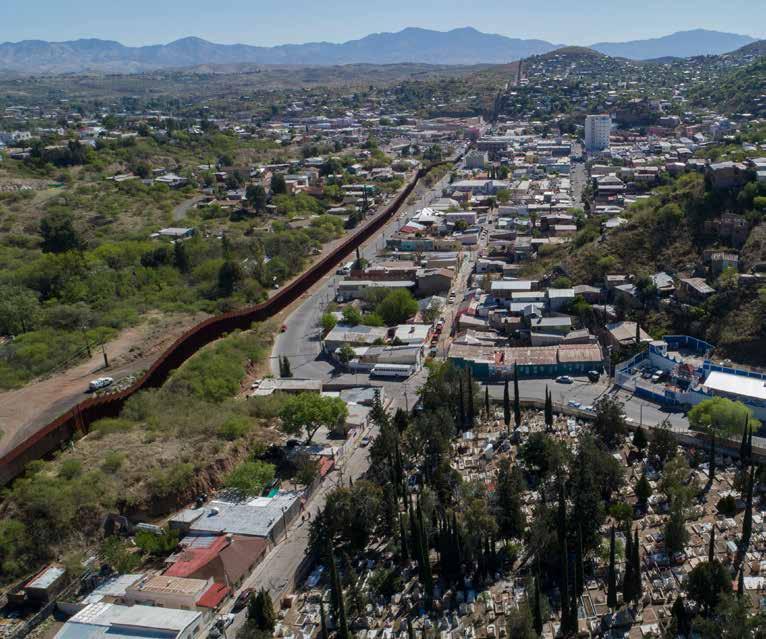

ABOVE: THE DOWNTOWNS OF NOGALES, SONORA, AND NOGALES, ARIZONA, FACE ONE ANOTHER — A RARITY FOR BORDER TOWNS.
LEFT: BORDER CROSSINGS HAVE GOTTEN INCREASINGLY BUSIER IN THE PAST TWO YEARS, BUT BUSY IS THE NORM IN NOGALES, WHERE 15,000 PEOPLE CROSS BOTH WAYS EVERY DAY.
JUNE 2024 35 AP PHOTO / RODRIGO ABD
GETTY IMAGES / JOHN MOORE

A MAN WALKS PAST THE RAZOR-WIRECOVERED BORDER WALL THAT SEPARATES NOGALES, ARIZ.,
Secretary Alejandro Mayorkas, but it lives on as a campaign point for Biden. In February, the same month Biden’s bill failed, House Republicans voted to impeach Mayorkas in an unprecedented move that was dismissed by the Senate two months later. Each of these opposing steps, made in the name of immigration reform, have ended in gridlock. Democrats are currently scrounging for an alternative plan to replace the defeated bill as all-eyes-on-it attention is on the politics of the border and the migrants who cross it. Yet little attention is paid to the life lived — and shared — in border communities most impacted by changes in policy.
It is in these small communities where the wall is not seen as a symbol of literal and political division, but a doorway that connects rather than separates. “Most of the people who are crossing the border in Nogales, they are locals who have border crossing cards or a special type of visa for binational residents, and they do it every day,” says Ieva Jusionyte, a legal and medical anthropologist who teaches international security at Brown University. “The border depends on circulation.” Nogales, the “gateway to North America,” demonstrates that neither Mexico nor the United States is a monolith — and that the intersection of the two is more of an interconnection.
IN NOGALES, SONORA, colorful homes are scattered like confetti among tawny hills. There’s a rhythm and bustle of passersby beyond the turnstile at the Dennis DeConcini Port of Entry in downtown Nogales, Sonora. This city is far larger than its Arizona counterpart, with some 265,000 people compared to 20,000.
Dental and medical offices pepper the streets. There’s “Dental Laser Nogales,” “West Dental,” “Nogales Dental Advanced” and “Arizona Dental Nogales,” each only about five minutes apart. A chorus of storefronts advertise services for Americans in search of cheaper health care — mostly in English. Many even accept American insurance. The familiarity is enough to create the illusion that one did not cross an
international border. In truth, much of the city’s downtown is catered to tourists, medical or otherwise. Cow skulls, embellished cowboy boots, sombreros, wrought-iron sculptures and tiny bobblehead turtles perch on shelves and are placed hopefully in front of shop doors.
Part of this focus on American visitors is the undeniable boon of their USD-fueled business. The Mexican city of Nogales brings in more than $450 million in international sales annually. More than 100 manufacturing plants, exporting goods from computers to car parts, contribute the majority of that revenue. The rest relies on steady foot traffic crossing the border. “The majority of clients are Americans here, about 70 to 80 percent,” says Silvestre Castro, the head waiter at La Roca, a restaurant a quick walk from the port. (He’s worked there for 30 years. Every day, he wears an ironed suit and tie to wait on American customers — which he says is his favorite part of the job.) Luz Amelia, who owns the Panadería La Espiga de Oro bakery less than one mile from La Roca, tells a similar story. “A lot of Americans come to the bakery and bring the bread back home as far as Phoenix or Las Vegas,” she says. Amelia orchestrates the orders from behind the counter, with an open binder of decals and designs for custom cakes in front of her while a line of customers clutching their pastries wait to pay with both Mexican pesos and American dollars.
For all the merchants in Sonora who count on sales to Americans, locals in the U.S. are arguably even more dependent on tourists who cross north into Nogales, Arizona. When the pandemic shut down the border, Evan Kory called it a worst-case scenario. The shoe store and bridal shop his family owns on Morley Avenue, La Cinderella and Kory’s Bridal, lost as much as 30 percent in sales. They couldn’t afford to hire employees, so family members took on shifts, keeping the stores open for a few hours at a time.
The shops fully reopened in 2021, offering the family a much-needed financial reprieve until the Lukeville border closed
36 DESERET MAGAZINE
LETTERS FROM THE FIELD AP PHOTO / RICHARD VOGEL
LEFT, AND NOGALES, SONORA, RIGHT, ON MARCH 30, 2019.
in December. Overcrowding caused wait times in Nogales to jump from an average of half an hour to three hours. Shoppers were disincentivized from crossing into Arizona from Mexico and once again, life appeared dire. “It was excruciating. And we didn’t even care about the fact that the business was struggling,” Kory says. “It was more about, where are the people? We’ve lost who we are.”
THE MAIN REASON for the visible crisscross of languages, currencies and cultures in Nogales is a history that predates the border. Anasazi, Hohokam, Apache and Yaqui tribes lived in the region long before European settlers, with the Nogales area serving as a stop on a trade route that bridged Indigenous communities — setting the foundation for the binational nature of Nogales that persists today. It was only after the Gadsden Purchase in 1853 that the two sides were definitively and finally bisected into separate settlements.
Still, the two cities are often referred to as one, as “Ambos Nogales,” or “both Nogales.” The first chain-link fence that ran through them was put up during the Mexican Revolution in 1915; something to draw a new line in the sand, though crossings were common and uneventful since families spanned across either side. A spirit of unity — even at the official level — persisted regardless. “A collaboration between fire departments was older than the border fence,” Jusionyte, the professor at Brown University, says. She has also volunteered as a first responder in Nogales, and authored the book “Threshold: Emergency Responders on the US-Mexico Border.”
Today — despite the barbed wire and towering steel structures that stand in place — the same is true. Data from the Government of Mexico shows more people have come from the United States into Nogales, Sonora, in the last five years than from anywhere else. Most of these visits are to see family. “You have all these people whose lives are on the border … not divided by the border, but united by the border,” says
Randall H. McGuire, an archaeologist who has researched and worked in Nogales, Sonora, for four decades. “It’s often regarded as the most integrated of border communities on the U.S.-Mexican border. It was the only one that was built with the downtowns facing each other.”
When borders close and policies change, families are separated. Castro tries to go to Nogales, Arizona, with his 16-year-old a few times a month to shop and to visit his uncles and cousins in Phoenix. Amelia tries to cross at least once a week to spend time with her three sons in Nogales, Tucson and Phoenix. However, with the election looming and border policy dominating the national agenda, it’s crossed their minds that their access could change. “People outside
“WASHINGTON CANNOT DICTATE OUR CITY FROM SITTING BEHIND THE DESK AND NOT TALKING TO US — I WISH THE FEDERAL PEOPLE THAT RUN THE COUNTRY FROM OVER THERE WOULD TAKE US INTO CONSIDERATION.”
of the border region just can’t seem to wrap their head around the fact that it’s possible to be binational as a person,” Kory says. “Nogales really is that way.”
Fernando Urias, battalion chief of the Nogales Fire and Medical Department in Arizona, references the modern history that both cities share. He can cite several examples of fire suppression efforts that have continued to cross the border in his 20 years in the department. The most famous took place a dozen years ago when a hotel caught fire just beyond the border in Sonora. Firefighters from Arizona stationed a fire truck beside the fence and lifted a crane across to douse the flames with jets of water.
The image circulated nationally. It depicted a clear moment of solidarity despite the obvious barrier below. The aid has been reciprocated. When another emergency broke out on the Arizona side of the fence some years later, the volunteer firefighters, or bomberos, responded. They arrived in a pickup truck to put out a residential fire that had spread from one house to five. “If you told somebody that, they would probably think you’re telling a tale, but that’s how it went down,” Urias says. “They showed up in the back of a truck and got to work.”
For both sides, living on the border means fires — literal or otherwise — are shared. But Urias now fears that political tensions could stand in the way of communities, families and officials coming together. “I think times have changed,” he says. “Not saying that it can’t happen, I just don’t foresee it happening with all the politics.”
Some border states have grown so tired of not feeling heard by the federal government that they’ve pushed to circumvent it altogether. In Texas, a law that went into effect in March makes illegally crossing the border a state crime and gives local law enforcement the authority to arrest migrants. “Washington cannot dictate our city from sitting behind the desk and not talking to us — I wish Washington and the federal people that run the country from over there would take us into consideration,” says Jorge Maldonado, mayor of Nogales, Arizona. To him, policy and politics bring awareness to issues, but not the complexity of those issues.
“For too long, we all know the border’s been broken,” Biden said during an attempt to rally support for his bill. Over 2,000 miles away from D.C., that brokenness — the gaps in border policy — are manifested in literal gaps like the Mariposa Slab, functioning as an albatross of sorts: What were once considered doorways have become holes. But once they are sealed, what comes next? The Mariposa Slab looms on the periphery, and every morning, the sun shines through that gap into an uncertain future.
JUNE 2024 37
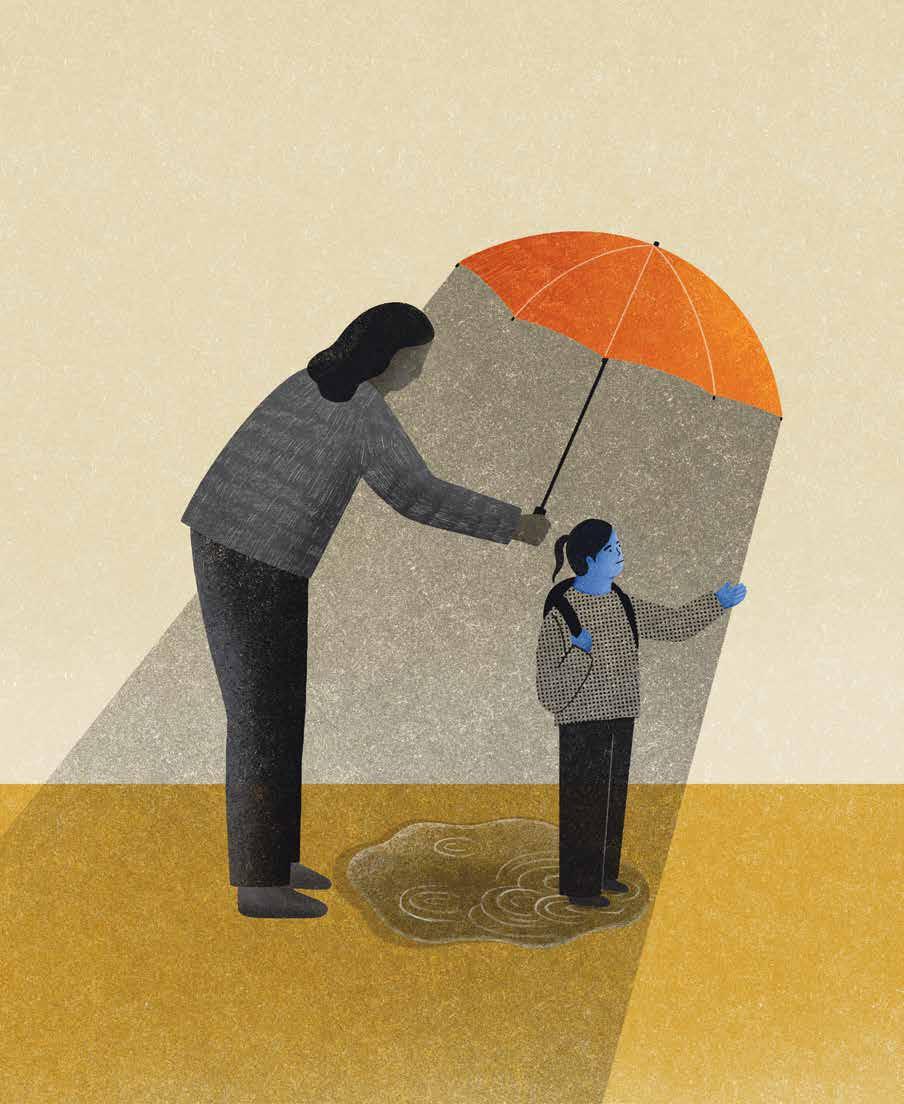 BY
BY
THE NEW DEBATE OVER
THERAPY
JUNE 2024 39
JEAN M. TWENGE ILLUSTRATION BY SUNNU REBECCA CHOI
the teen mental health crisis raging, there’s another potential answer for what might be causing so many young people to be depressed and anxious. This answer is new and counterintuitive: psychological therapy.
In other words, what we thought was the cure is actually the cause.
The theory is laid out in a new book whose title sums up its central premise: “Bad Therapy.” The book, written by journalist Abigail Shrier, has clearly touched a nerve: At one point it was the No. 1 selling book on Amazon.
Much of the book resonated with me as a culture researcher and as a parent. However, some of the book’s arguments fell flat, or were not supported by the research evidence. I’ll start with the conclusions I think are questionable, and will then move on to what I think the book gets right.
40 DESERET MAGAZINE
1More teens are severely depressed, and therapy works.
Shrier argues that most teens who are depressed or anxious don’t need therapy. Instead, they need their parents to set better boundaries and stop focusing on their feelings so much.
In an author’s note at the beginning of the book, Shrier writes that her book is not about teens who suffer “from profound mental illness. Disorders that, at their untreated worst, preclude productive work or stable relationships and exile the afflicted from the locus of normal life. … These precious kids require medication and the care of psychiatrists.”
The problem is these types of severe problems are no longer rare. One example is a major depressive episode with severe role impairment. That means a teen fits the diagnostic criteria for major depression and that the disorder is severely interfering with school, work, social life, chores at home and/or relationships with family. That hews fairly close to Shrier’s words (“Disorders that, at their untreated worst, preclude productive work or stable relationships”).
In recent years, more than 1 in 5 adolescent girls in the U.S. fit criteria for major depressive episode with severe role impairment, nearly triple the rate of 2011. One in 14 boys also experienced major depression with severe impairment, twice as many as in 2011 (see Figure 1).
Presumably we can all agree that teens with severe role impairment need therapy and/or medication. Are they getting it?
Only about half are: In my analysis of the National Survey of Drug Use and Health dataset, 48 percent of adolescents with major depressive episode with severe impairment received either therapy or medication in 2020-2022. You can probably guess who was more likely to get it (higher-income teens,
at 51 percent) and who wasn’t (lower-income teens, 44 percent). The group with the lowest percentage getting help were middle-income teens, at 41 percent — presumably because they fall into a “doughnut hole” of making too much to get government services like Medicaid but not enough to afford therapy.
On average, therapy works: Depressed people who receive psychological therapy or antidepressant medication improve more and faster than those who don’t. Shrier is correct that improvements with therapy are not as large for teens as they are for adults. Still, depressed teens who do not get therapy are twice as likely to get significantly worse than those who do.
I’m also not so sure that putting a child in therapy gives the child the message that the parent thinks “there’s something wrong with her,” as Shrier writes. It might send the message that the parent is paying enough attention to know that they are struggling. That’s a lot more than many teens get.
This is a general issue with the book, which is clearly aimed at parents who are
middle-class and up and who pay a lot of attention to their kids. A sizable chunk of teens who are unhappy, depressed and lonely got that way partially because their parents ignore them or are too busy working two or three jobs to talk to them much. Too much attention isn’t the only parenting problem out there.
I agree we can do a better job as parents and as a society preparing our teens for adulthood. Having teens do more out in the physical world and focus on their feelings less is a plausible pathway for many. Still, I fear that for some parents, policymakers and educators, the message will be read as: Therapy is bad. We need less of it.
But for clinically depressed teens, especially those with severe role impairment, we need more therapy, not less. We also need more research and thinking about how to make therapy more effective for teens or find other types of interventions that can help. But suggesting they “shake it off” (as Shrier’s book suggests in its conclusion) is probably not the best approach.
JUNE 2024 41
FIGURE 1 Major Depression with Severe Impairment by Gender
2
Emotional difficulties are a spectrum, not two distinct categories.
“Talk of a ‘youth mental health crisis’ often conflates two distinct groups of young people,” Shrier writes. The first is the teens with severe issues. Then there is “a second, far larger cohort: the worriers; the fearful; the lonely, lost, and sad. We tend not to call their problem ‘mental illness’ but nor would we say they are thriving.”
This draws a bright line between teens who are lonely, worried or sad and those who have major depression. However, these are not two completely distinct categories of people.
Emotional tendencies exist on a spectrum. Some people are more prone to anxiety than others, and among some that rises to the level of a disorder (such as generalized anxiety disorder). The character of the feelings are not that different; the primary difference is how much the anxiety interferes with normal life. Not surprisingly, people who are above average in anxiety are also more likely to have an anxiety
disorder at some point in their lives. They then might get better, only to experience an anxiety disorder again later. The line is fuzzy, and people cross it all the time.
Plus, teens’ feelings of loneliness and hopelessness have increased in lockstep with more severe issues such as a major depressive episode (assessed using the Diagnostic and Statistical Manual of Mental Disorders criteria). The number of teens who agree they feel lonely is actually fairly similar to the number who suffered from major depression in the last year, as is the number who agreed or mostly agreed that they felt the future was hopeless (see Figure 2). These are from different surveys of different teens, so we don’t know if all the lonely or hopeless teens are also depressed and vice versa. But this suggests to me there is not a stark division between the lonely and hopeless teens on the one side and the clinically depressed on the other, as Shrier writes.
The best parenting style is not authoritarian (the old-school “follow my rules or else” model) or permissive, but authoritative — a loving parent who sets clear boundaries.
3
Gen X teens didn’t exactly have the best outcomes.
Shrier’s overall argument is that Gen X parents should be raising their kids the way they were raised — with less technology, more freedom and independence, and less parental involvement. I’m in agreement with the part about less technology; the smartphone and social media era lines up perfectly with the rise of teen depression, and social media use among teens is now so high (five hours a day, according to Gallup) that it hardly seems controversial to suggest some cutting back.
But we can’t sugarcoat the past. The Gen X adolescence had lots of great things like driving around with your friends away from your parents’ watchful eyes and learning to navigate the world independently. But that freedom had downsides: high rates of teen pregnancy and homicide. Both of these reached all-time peaks in the late 1980s or early 1990s, the prime years of the Gen X adolescence (see, for example, the Gen X chapter of “Generations”).
42 DESERET MAGAZINE
FIGURE 2 The Spectrum of Emotion
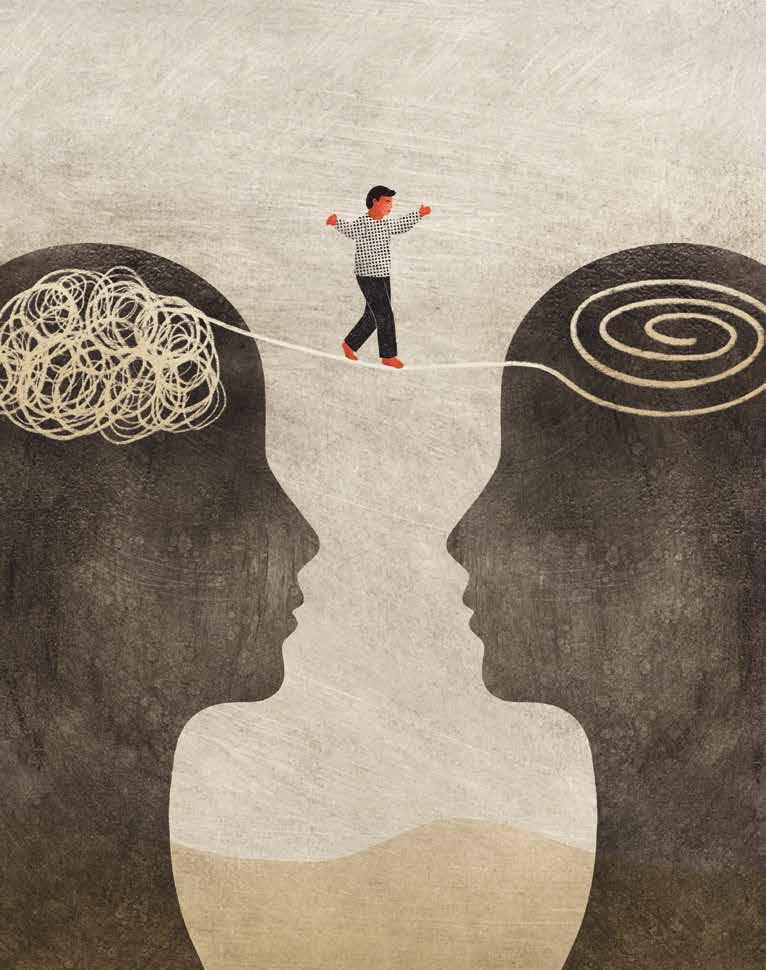
JUNE 2024 43
Twentieth-century parents’ benign neglect wasn’t always so benign.
We don’t have stats on depression comparable to today’s data going back to Gen Xers’ teen years, but by most indicators Gen X was not in robust mental health during their adolescence. More said they were unhappy than boomer teens did, and teen suicide rates spiked to very high levels in the late 1980s and early 1990s. In adulthood, Gen Xers’ depression rates are about the same as boomers’ at the same age, sometimes a little lower — but that’s not a high recommendation given that boomers were considerably more depressed than the generations before them. The Gen X experience was far from ideal for mental health, especially during the teen years.
4
Growing
up slowly is not all bad.
The subtitle of “Bad Therapy” is “Why the Kids Aren’t Growing Up.” Shrier argues that teens are not taking on adult tasks like driving and dating because they have been emotionally stunted by their over-involved parents. But these trends are just a small part of a bigger one: Because modern citizens live longer and more education is necessary to succeed, the entire life trajectory has slowed from infancy to old age. Psychologists call it a slow life strategy. Children and teens are less independent, young adults marry and have children later and
settle into careers later, middle-aged people look and feel younger than their parents or grandparents did at the same age, and older people enjoy more years of good health.
As these examples show, these changes are not all negative. Yes, teens are less independent and often don’t get enough experience making decisions on their own before they go to college or enter the workplace. But teens are also less likely to drink alcohol and have sex. In the early 1990s, the majority of eighth graders — 13 and 14 years old — had already tried alcohol. Now it’s about 1 in 4. Suddenly today’s parents don’t seem like they’re doing such a bad job. What ties these trends together — less driving, less drinking alcohol, less dating, less sex — isn’t how good or bad the trends are. It’s that teens are simply taking longer to do adult things. Their parents are also taking longer to give up their skinny jeans and ironic T-shirts because they don’t feel old yet. Everyone’s life trajectory has slowed down, and that’s not necessarily bad.
ALL OF THAT said, the book does make many good points that parents should be aware of — with a few important qualifications.
1
Kids need parents to set boundaries.
Shrier argues that parenting has become more permissive, with a dose of helicopter thrown in. Many parents now
Trying to administer mental health interventions to all teens, regardless of whether they need it, can backfire.
focus on their kids’ feelings and do everything they can to minimize discomfort and sometimes even challenge.
It’s clear that parents are less likely to act as authority figures today and that they are less likely to prohibit children from expressing anger toward them. As Shrier correctly notes, the best parenting style is not authoritarian (the old-school “follow my rules or else” model) or permissive, but authoritative — a loving parent who sets clear boundaries. Even the middle-ground authoritative style seems to be more rare today as permissive parents favor wanting their kids to be happy all the time.
Shrier also notes the recent emergence of so-called “gentle parenting” that refuses to use any kind of consequence even for behavior like the child hitting the parent. We don’t have good data on how common “gentle parenting” is now, but it’s certainly been widely discussed online lately. Shrier is right that we should question this idea. One of the bedrock findings of psychology is that behavior modification (rewards for good behavior and punishment for bad behavior) works, especially when focused on deprivation of experiences rather than physical punishment. That means consequences like timeout for younger kids and taking away privileges (TV time, car keys) for older ones. Kids and teens do best when parents set clear expectations for behavior and enforce them.
However, that should not — as Shrier argues — mean a return to spanking, which effectively says, “Let’s teach kids that hitting each other is wrong by hitting them!” It doesn’t work. Decades of research show spanking leads to defiance, not cooperation, and is bad for kids in the long run. Also true: Parents don’t have to give in to their kids’ feelings all the time. Children need parents who don’t cave when a 10-year-old says they don’t want to put away their laundry (because, as a mom, I don’t want to put away my own laundry either — but we all have responsibilities and kids need to learn that). Teens need parents who trust them to do things on their own
44 DESERET MAGAZINE
For clinically depressed teens, especially those with severe role impairment, we need more therapy, not less.
(turning in homework, making a doctor’s appointment, figuring out their class schedule), even if this means facing their fears or failing every once in a while. I agree with Shrier that in trying to protect our kids we can leave them unprepared for adulthood. My own kids, now all adolescents, have benefited greatly from the experiences they have had on their own: flying alone, going to sleepaway camp, finding their own way to school.
2Applying therapy techniques to everyone can backfire.
Here’s one place where Shrier’s counterintuitive take is right on: Trying to administer mental health interventions to all teens, regardless of whether they need it, can backfire. Researchers in Australia tried this, teaching 12- to 14-year-olds skills sometimes taught in therapy such as mindfulness, reappraisal and acceptance and asking them to do homework assignments to build these skills. They thought these students would do better than an untreated control group. Instead, they got worse — they reported more anxiety and depression after participating in the program than they had before it.
For the average teen who’s reasonably happy, thinking too much about their emotions
might lead them to focus too much on their negative feelings. Just as it wasn’t the best idea to try to boost kids’ self-esteem when most already felt just fine about themselves, trying to teach therapy techniques to all teens might not be a good idea.
If we’re going to try to prevent depression among teens before it starts, we could instead consider teaching them what we know works: Get enough sleep, go outside, exercise and spend time with people in person. A great blueprint for these types of lifestyle changes is in the book “The Depression Cure.”
3
The best cure for fear is experience.
Shrier notes that many parents shield their children from experiences that may be risky (either physically or emotionally), thinking that this is compassionate. Many kids and teens do seem to be afraid to do things their parents regularly did as children, like walk home from school, ride their bikes with their friends or even call someone on the phone.
Fortunately, fears and phobias are among the most easily treated of all psychological ailments — in fact, they can often be effectively cured in one session. In less severe cases, they can be treated by slowly easing toward and then doing what you’re afraid of. You do it, you don’t die, and then you’re less scared of it. Our kids and teens need to know this is how our brains work.
4
Phones and social media are not real life.
Shrier and I agree that today’s parents have overprotected their kids in the
physical world and underprotected them in the online world, partially because parents are unwilling to fight with teens about their phones.
That said, parents are in an almost impossible position these days because parental permission is not required to open a social media account and age is not verified. We can buy them phones (like Troomi, Gabb or Pinwheel) that don’t have social media access, but it is very time-consuming and difficult to police every device kids have, especially when they use laptops to do homework. We can’t blame this problem solely on parents — we need governments to step up with better regulation. We also need to join together and help each other. So yes, let’s encourage kids and teens to get off their phones, but realize we can’t do that alone.
Overall, it seems unlikely that the rise of therapy caused the increase in teen depression that began around 2012. Therapy works better than doing nothing, even for teens, so if a proliferation of teens were getting therapy, severe depression should have gone down, not up. Parenting has become increasingly permissive for decades, not just during the last 10 or 15 years. Yes, more schools now focus on mental health and wellness, but that might be because more students are depressed and anxious; the causation might be reversed.
I agree with Shrier that parents should not be so quick to try to protect our kids, and that kids thrive with structure and clear boundaries. Blanket mental health interventions for all kids can backfire. But the message can’t be that all therapy is bad — too many teens are suffering too much, and therapy can help at least some of them. Until we have a better strategy than “shake it off,” we have to at least try.
JEAN M. TWENGE
JUNE 2024 45
IS A PROFESSOR OF PSYCHOLOGY AT SAN DIEGO STATE UNIVERSITY AND THE AUTHOR OF “GENERATIONS” AND “IGEN.”

CONDOR CONSIDER THE
ONCE ON THE BRINK OF EXTINCTION, THE BALD, FEATHERED SYMBOL OF THE WEST IS MAKING A PROMISING COMEBACK. IF ONLY WE CAN GET THE LEAD OUT
BY MARLOWE STARLING | ILLUSTRATION BY OWEN DAVEY
JUNE 2024 47
EXPLORERS AND SETTLERS couldn’t agree on whether they beheld beauty or beast. In 1806, on the banks of the Columbia River, William Clark jotted in his journal that the California condor is “a handsom bird,” an observation later contradicted by an account in the Sacramento Daily Union describing “a huge monster” that terrified the residents of a small Nevada outpost. In the same era, Scientific American called them “as graceful and majestic as any bird in the world,” only to be disputed by Field & Stream, which described the California condor as evil looking, “like a cross between an executioner and an undertaker.”
Bald and hunchbacked, with a head that changes from peach to orange to yellow depending on its mood, and tufts of black plumage that poof out from the base of its wrinkly neck like a fur coat on an elderly woman, Gymnogyps californianus is a bird of contradictions. A symbol of both death and resurgence. The sight of one wheeling overhead signals another animal’s passing — and the vulture’s next meal — but as a species, it has survived multiple brushes with mortality.
In 1982, just 22 remained in the wild. Today, there are about 560. Curiously, the culprit of the condor’s precipitous decline in

48 DESERET MAGAZINE

the last century — and what keeps its numbers dangerously low now — measures less than two inches long and weighs less than 10 grams. The lead bullet, the very tool those European settlers used to colonize the West, has placed condors in near-constant mortal peril. While predators, vehicle collisions, electrocution from power lines and forest fires also kill condors, none are as detrimental as lead poisoning, which kills half the population annually. Because they constantly feed on carrion, and because they congregate in groups — they’re as socially attached to each other as we are — a single lead-laden carcass can poison multiple birds at once. “It only takes one little lead fragment that’s as big as a couple of grains of sand,” says Myra Finkelstein, an environmental toxicologist at University of California, Santa Cruz. “That has enough lead to kill a condor.”
To keep the species from disappearing forever, fewer lead bullets will need to litter the West, and scientists will need to continue the project that brought the birds back from the brink. In the 1980s, researchers captured all 22 birds, held them in a breeding facility, and raised their chicks before releasing them back into the wild. As one of the first animals listed under the Endangered Species Act, the condor’s recovery was deemed a testament to federal wildlife protections.
or I can introduce myself as a lifelong hunter,” says Chris Parish, president and CEO of the nonpartisan nonprofit The Peregrine Fund. His choice depends on the audience. Parish, who’s goateed and wears a cowboy hat, grew up hunting in a ranching community in the San Joaquin Valley, just outside of Bakersfield. The region is California’s biggest source of oil production. It’s also the heart of condor country.
In 1950, at the onset of the Korean War, locals revolted against plans for a condor sanctuary in lieu of oil development. And when the Endangered Species Act was passed in 1973, people thought it “threatened the way we lived,” Parish recalls — namely, tightening regulations on hunting and land development. In a 1994 article in Outdoor Life about the legislation’s renewal, the Sportsmen’s Coalition for Common Sense Amendments to the ESA suggested that “radical animal rights activists are using the law to advance their agenda.”
BECAUSE THEY CONSTANTLY FEED ON CARRION, AND BECAUSE THEY CONGREGATE IN GROUPS — THEY’RE AS SOCIALLY ATTACHED TO EACH OTHER AS WE ARE — A SINGLE LEADLADEN CARCASS CAN POISON MULTIPLE BIRDS AT ONCE.
Today, those efforts continue, led by conservation biologists as vehement about the dangers of lead as they are committed to reintroducing more raptors into the wild. Some may seem as contradictory as the birds themselves.
“I CAN INTRODUCE myself as someone who spent 23 years trying to recover the condor,
The debate had split into a conservationist-versus-hunter dichotomy. Yet, “some of the most successful and renowned hunters were the forefathers of ornithology,” Parish says, citing European explorers known for their scientific discoveries. Plus, he adds, anyone who shoots an animal with a lead bullet and leaves the cadaver — be it cattle, horses, coyotes or ground squirrels — is exposing wildlife to lead.
Parish now spends a good chunk of his time shooting copper and lead bullets into plastic barrels filled with water bags and ballistic gel. It’s a key part of the Non-Lead Partnership he helped kick-start in 2018 to educate shooters about what happens when a lead bullet enters a carcass. Hundreds of
JUNE 2024 49
THE PEREGRINE FUND
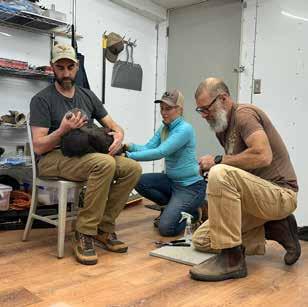
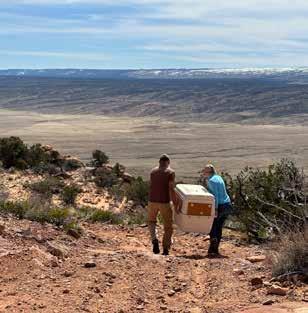
tiny shards spray into the flesh, making it virtually impossible for a scavenger to avoid. Copper bullets, on the other hand, retain their shape, splaying open like a flower without shattering.
Finkelstein, the environmental toxicologist, has co-authored studies on lead poisoning in birds over the past two decades. Her team’s recent work shows it wouldn’t take much to tip the scales in the condor’s favor. Just a 1 percent reduction in lead poisoning would equate to releasing two to three captive-reared birds. That’s significant when condors only produce one chick every other year and don’t breed until six to eight years old, making natural reproduction painfully slow.
The shooting demonstration has helped nearly 90 percent of the region’s hunters, ranchers and other shooters decide to switch to non-lead ammunition or to remove carcasses shot with lead. It doesn’t just help condors. Bald eagles, golden eagles and other animals — including humans — are likewise affected by lead poisoning.
confesses. His dark beard is now speckled with gray, and his ball cap depicts the endangered bird of prey. “It’s not hard to fall in love with this species.”
Still, it isn’t easy to convince people to stay in remote Marble Canyon, where the closest grocery store is 45 minutes away and you’re forced to be alone with your thoughts. But those who care enough will stick around for decades. Shawn Farry, a veteran conservation biologist who joined us on the bridge that morning, should know. He was around for the first-ever release in 1996. If lead poisoning continues to kill more birds than are born, it’s possible that in the Condorks’ lifetimes, they will never see a completely self-sustained population. But that’s the goal — to work themselves out of a job.
“THE PROBLEM WITH CONDORS IS THEY HOOK YOU. IT’S NOT HARD TO FALL IN LOVE WITH THIS SPECIES.”
“Where we fail is not in the science,” Parish says. “We fail in talking about what the implications from our findings are.”
ON A CLEAR-SKIED morning in March, biologist Tim Hauck met me on Navajo Bridge in Marble Canyon, Arizona, to watch condors soar and swoop above the turquoise Colorado River.
These rust-colored canyons are a magnet for people who are running from something or looking for something, Hauck recalls Parish telling him. An ornithology graduate from Rochester, New York, Hauck wasn’t sure what he was looking for when he joined the condor crew 20 years ago. What he did find was a family, The Peregrine Fund condor-recovery team. They call themselves the Condorks. “The problem with condors is they hook you,” Hauck
“We know that canyon, don’t we, Shawn,” Hauck said to Farry, peering through binoculars. They remember that canyon like a nightmare.
One year earlier, some of the condors’ tracking devices suddenly went motionless. It could have meant three things: The trackers fell off, the birds were listless from lead poisoning or they had died. The second option seemed most likely. But as more trackers went still, the crew grew worried. So when Hauck and Farry had spotted a single wing sticking out from the canyon cracks, they assumed the worst. An inflatable National Park Service boat scooped them up, and as they drew close to the motionless carcass, they readied a body bag.
But the bird blinked. It was still alive. They were used to seeing lethargic condors with lead poisoning, but this one was worse. Hauck cursed in anger as he carried the sick condor back to the boat, cradling her in his arms, wishing she were dead instead of suffering. They sent her to Liberty Wildlife hospital in Phoenix, hoping for a miracle. She died a day later.
50 DESERET MAGAZINE
TIM HAUCK (TOP LEFT), BRIANNA BODE AND SHAWN FARRY, SELFDESCRIBED CONDORKS, HAVE SPENT YEARS INTRODUCING CONDORS BRED IN CAPTIVITY INTO THE WILDS OF MARBLE CANYON, ARIZONA.
MARLOWE STARLING
It wasn’t until they collected almost two dozen sick birds that they found an answer. HPAI, the avian influenza that has spread from poultry to cattle and other animals, had snuck up on condors like a plague. The biologists spent 12-hour days rappelling down cliffs wearing PPE to rescue as many sick birds as they could. In just three weeks, they lost a fifth of the population — a setback equivalent to almost 20 years of conservation efforts. “It was like the biggest monster that you’ve ever seen, just rose up out of the depths, out of nowhere,” Hauck recalls. “There was nothing you can do.” A spectator sport, one USDA virologist brutally put it. Unlike the lead threat, they had no control over this one. Eventually, the deaths stopped, and condors became the first animal to be
vaccinated for avian flu. But it threatened to wipe out decades of conservation progress in a blip.
A CONDOR DOESN’T just fly; it glides. An adult condor’s wingspan can stretch as wide as 9.5 feet, and it can weigh up to 26 pounds. That’s a lot of body weight to haul through the air, and yet, they manage to effortlessly soar up to 200 miles in a single day. Masters of aerodynamics, they stretch their wings out straight to gain elevation and curve them inward to swoop down. The edges of their wings span out into a feathery fringe, making a soft, fluttering noise you can hear when they fly overhead. Crane your head up toward the sky, and you’ll see the white patch of plumage that spreads along the length of each underwing against
the black of its body, and between them, the pink dot of its head.
Today, the raptors reign over an impressively wide terrain, from coastal California to northern Mexico, and from the desert cliffs of Arizona’s backcountry to southern Utah. But thousands of years ago, the condor’s kingdom was much larger. Fossil records indicate that its historic range once extended as far southeast as Florida and as far northwest as British Columbia, at a time when megafauna like sabertooth tigers, mastodons and American cheetahs roamed the land we now call North America.
Scientists aren’t sure how many condors existed back then, but it’s clear that the condor’s demise started around the same time that Europeans arrived. By the time

Lewis and Clark set out on their expedition in 1804, the population was already in decline. Cattle carcasses intentionally poisoned in order to kill predators like coyotes, bird hunting and the lucrative egg trade were likely contributors to the condor’s demise. But so was lead poisoning. With the lust for gold, timber and Manifest Destiny came lead ammunition. “The report that the California condor will soon become extinct is not without foundation,” Scientific American reported in 1908. “Unless the needed protection is given, this bird will undoubtedly follow the great auk,” a penguin-like bird in the North Atlantic that went extinct in the mid-1800s.
In California, fish and wildlife biologist Steve Kirkland took me to Bitter Creek National Wildlife Refuge, about two hours north of Los Angeles. When we stopped for gas in Frazier Park, a local in his 70s shared a new nugget of information: In the 1960s, dozens of condors would congregate around the gut piles on a nearby turkey farm. It was the first time Kirkland had ever heard of condors in that area. “We’re learning as we go,” he says. “Nobody who’s alive has ever seen a healthy population.”
and beat its wings once, twice, before it was effortlessly riding the wind. The bird climbed higher until it was a mere speck above the mountains, and then, it was gone.
THE RAPTORS REIGN OVER AN IMPRESSIVELY WIDE TERRAIN, FROM COASTAL CALIFORNIA TO NORTHERN MEXICO, FROM ARIZONA’S BACKCOUNTRY TO SOUTHERN UTAH. BUT THOUSANDS OF YEARS AGO, THE CONDOR’S KINGDOM WAS MUCH LARGER.
In the foothills of the Coast Ranges, Kirkland and I stood on a picnic table with a pair of binoculars overlooking the expanse of the San Joaquin Valley: the farms, the oil rigs and, barely visible, the Sierra Nevada mountains on the horizon. This valley is the condor’s 14,000-acre foraging ground. Finally, we spotted one — an untagged juvenile sitting just 30 feet away from us. Untagged means wild-born, which is a good sign of natural reproduction. The young bird silently pushed off the ground
AFTER A CHICK is born in captivity and raised in a facility like the World Center for Birds of Prey in Boise, Idaho, it’s sent off to Arizona or California for release. Condors, with their razor-sharp beaks and taloned kicks that can bruise, are not easy birds to handle. I found out for myself atop a plateau at Vermillion Cliffs National Monument in Marble Canyon, where I joined the Condorks to prepare adolescent condors for release into the wild. The itinerary was deceptively simple: Capture four condors from a large flight pen — by hand — and transport them to the release pen and lab where the biologists run health checks and bestow each condor with the brand-new wing tags they will wear for life. Hauck, Farry and fellow biologist Brianna Bode loaded ATV s with empty dog kennels and garbage bags full of frozen calf carcasses — a tasty treat for the condors when they’re done. “You’re going to watch us look like fools for a few minutes while we try to catch condors,” Hauck told me as we approached the flight pen. Inside, Hauck and Farry chased around the raptors as they flocked from one end of the enclosure to the other. They eventually guided four of them into their respective kennels, lifted each kennel onto an ATV, strapped them down securely, and four-wheeled off to the release pen.
There, the crated condors sat in silence awaiting their examinations. But inside, the team of three deftly hurried from one task

52 DESERET MAGAZINE
THE PEREGRINE FUND

to the next. Hauck and Farry punched holes into vinyl cattle-ear tags that they fashioned into wing tags. Bode labeled tiny vials for blood samples. Hurried hands affixed each tag with a radio transmitter.
One by one, the birds underwent their checkups. One person wrangled a condor into a firm embrace, stood on the scale, and then took a seat, bird in lap, index finger and thumb gently wrapped around its beak. Another biologist ran physicals and drew blood. Wings pierced and tags affixed, each bird was ushered into the release pen to acclimate to their new habitat. In about a week, all four birds would join the others in the Southwest flock.
Later that evening, at the base of Vermillion Cliffs, more Condorks joined to observe the progress of the birds that had been released a few weeks earlier. The biologists’ shadows stretched long as they peered into their scopes. “I’ve got eyes on 33,” one said into her radio. “Copy that,” Bode replied from the top of the cliff, voice gravelly through the airwaves. If a bird settles in a spot that makes it vulnerable to predators, Bode’s job is to scare it off by any means necessary — yelling, waving arms, sometimes howling like a coyote — in a teaching process biologists call hazing. Another Condork followed 1083 through his scope as the youngling attempted a shoddy landing. “My man!” he exclaimed, cheering him on for a second attempt.
To our right, the canyons turned purple with the sunset. We watched as the birds soared around the cliffs until each found its favorite spot to snuggle in for the night. To the average person, watching floating specks through spotting scopes for hours each evening might seem like a slog. But for as long as lead poisoning remains a threat to their survival, the Condorks’ focus stays fixed. In a few years, the inexperienced fliers will reach mating age and couple with a partner. Hopefully, they breed a wild chick, one that isn’t born in captivity for a change. And soon, the four new birds will join them, wings spread wide above the canyons.
JUNE 2024 53
SEEN BY SOME AS “MONSTERS” IN THE 1800S, CALIFORNIA CONDORS HAVE HEADS THAT CHANGE FROM PEACH TO ORANGE TO YELLOW, DEPENDING ON THEIR MOOD.
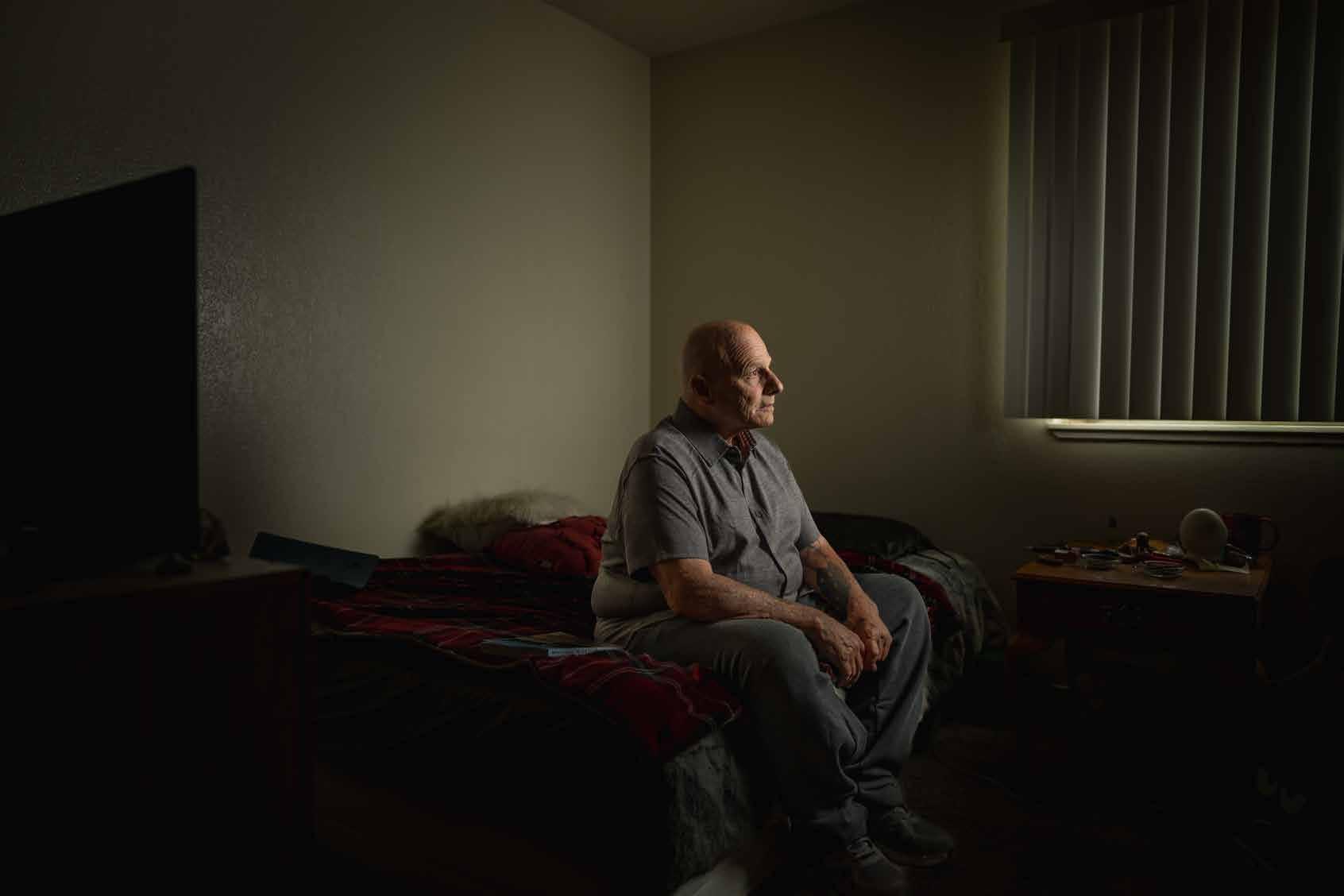
FRANK DE PALMA SPENT A THIRD OF HIS LIFE IN SOLITARY CONFINEMENT. RESEARCHERS AND LAWMAKERS ARE ONLY BEGINNING TO UNDERSTAND WHAT THAT DOES TO A PERSON.

JUNE 2024 55
BY NATALIA GALICZA
PHOTOGRAPHY BY SPENSER HEAPS
It was midafternoon and the blinds were drawn. Splinters of sunlight pushed through the border of the windowpane, but for the most part, the office where Frank De Palma sat was dark. He preferred it this way; he found comfort in the absence of light. And in March 2021, as he prepared to testify before the Nevada Legislature, he needed all the comfort he could get.
“Please bear with me, I’m very nervous,” the 64-year-old pleaded to the Senate Judiciary Committee. He looked pale. His cheeks were sunken in and creased by time, his head cue ball bald. He tried to steady his focus on the Zoom call, to direct his gaze at the grid of state senators on the computer screen, but his eyes darted about wildly. “I’m really afraid,” he said, fidgeting in his seat. “I’m afraid I won’t be able to convey the truth as I lived it.” Frank had 20 minutes to distill two decades of his life in support of Senate Bill 187 — a bill to reduce the use of solitary confinement in Nevada’s state prisons. Though he was
not a policy expert or advocate with impressive credentials, he had intimate knowledge of the subject.
For more than 22 years, Frank sat alone in a cell at Ely State Prison, a maximum-security facility in northeastern Nevada. Now, seven years after his isolation and two years after his release from prison, he sat in front of a webcam to recount his experience.
“Darkness became like a blanket of protection to me,” Frank said. He admitted that he struggles to maintain a clear concept of time; that he tenses at the thought of anyone behind him while out in public; that, despite his best efforts, he still considers himself peripheral to society. More shadow than person. “There’s something in me that’s different.”
Frank’s story is emblematic of an American phenomenon. No country uses long-term solitary confinement more than the leader of the free world. More than 80,000 people on a given day experience solitary
confinement in prisons nationwide, according to the nonprofit watchdog group Solitary Watch. That number rises to about 123,000 when including jails. The state with the highest percentage of its prisoners in solitary, as of 2019, is Nevada. This punitive measure has burgeoned nationwide in the last few decades, as tough-on-crime politics gave rise to the creation of super-maximum security facilities. While these “supermax” units, which rely on isolation as a cudgel, were rare before 1990, they exist in 44 states today. Between 1995 and 2000, the growth rate of inmates held in solitary outpaced that of the general prison population by more than 10 percent. The practice grew in popularity, including out West. California’s Pelican Bay State Prison, built in 1989, was the state’s first supermax facility and remains one of the country’s most notorious. The Federal Bureau of Prisons’ ADX Florence facility in Colorado, built in 1994, is known as the toughest federal
56 DESERET MAGAZINE
prison in the country and is the bureau’s only facility to hold all of its inmates in solitary.
Prolonged isolation can cause post-traumatic stress disorder, paranoia, impulse control, loss of identity, psychosis. Memory failure, difficulty with concentration, an inability to grasp time. Hypertension, musculoskeletal pain, strokes. Some symptoms manifest in mere days. Many prove permanent or life-threatening. “If you’ve been in (solitary confinement) for years, decades even, it’s changed who you are. It’s changed your psychological DNA,” says Craig Haney, a social psychologist and leading expert on solitary confinement and its impacts on brain health. “You turn into somebody else. That somebody else may or may not be transformable back into the person you were.”
That somebody else will, however, encounter the general populace once they’re out of prison. Incarcerated people who endure even short-term isolation face a higher likelihood of
reoffending after their release; recidivism rates are as much as 15 percent higher for formerly incarcerated people who experienced solitary confinement than for those who didn’t. In the eyes of its opponents, it’s an issue of public safety as much as it is one of torture.
A recent wave of reform efforts hope to stanch that, including two bills awaiting action in the House and Senate to end the practice in federal prisons; more than 40 states have passed bipartisan legislation to place at least some limitations on solitary confinement.
“Punishment has got to be just and it has to be humane,” says Democratic state Sen. Pat Spearman, who introduced the Nevada bill. “Because if there are things that you do to people while they are incarcerated that warp their mind and make them worse mentally than they were when they went in, then people on the outside will have to deal with that.” Spearman was one of eight senators present during Frank’s testimony. The

bipartisan committee listened intently while the man in the half-dark spoke, to understand how he survived long-term confinement, and how he got there in the first place.
INCARCERATED PEOPLE WHO ENDURE SOLITARY CONFINEMENT ARE 15 PERCENT MORE LIKELY TO REOFFEND AFTER THEIR RELEASE FROM PRISON THAN THOSE WHO DON’T.
THE CELL WAS about four and a half steps wide. A small metal bunk sprouted from the wall. It faced a toilet. There was a desk beside the bunk, with a window above. Frank couldn’t see much when he looked out of it. Shadows shifting over the desert. Maybe a patch of sagebrush. Light extinguishing as day gave way to night. Sometimes he thought back to when he was 18 years old, sitting handcuffed in a transport van on his way from Las Vegas to Carson City. He had more than six hours to stare out the window then, admiring mountain ranges and lone bushes splattered across an otherwise desolate landscape as he inched closer to the Nevada State Prison.
An emotional decision he made as a teenager in the early 1970s had altered the trajectory of his life. Frank, his father, stepmother and older sister had recently moved to Las Vegas from Brooklyn, New York, when Frank’s dog, a Labrador named Bud, was killed. Frank saw it happen. A truck ran over Bud without stopping. Frank, short and plucky, was always quick to emotion and slow to curb his rage. He followed the driver of the truck home, stole the truck out of the driveway and drove it through the man’s house. The charges included grand larceny with a sentence of 10 years. He had the opportunity to get out on parole after
JUNE 2024 57
only a couple years if he didn’t accrue additional charges. But once his sentence began, he made mistakes far more consequential. Attacking another prisoner with a weapon, battery, second-degree murder. He says the murder was self-defense; an altercation with a member of a prison gang, all of which Frank had avoided joining despite the target he claims his independence placed on him.
When he and other inmates transferred to Ely State Prison, which would later replace the former facility, those crimes and their consequences followed him. In 1992, at 36 years old, correctional staff put Frank in solitary confinement. Due to his history of violence, they wanted to separate him from incoming gang members. In that room roughly the size of a parking space, there was no radio or television. No books or magazines. No social interaction. His only breaks from the same four walls were for showers or trips to the recreational yard a few hours each week.
As the days turned into months, Frank’s time in lockdown appeared longer than it should have for a precautionary placement. He grew leery of guards, and eventually he cracked. While escorted out of his cell one day, he attempted to murder a correctional officer by strangling him with his chains. After that, he stayed locked in his concrete room with no clear end in sight.
The United Nations defines solitary confinement as isolation for 22 or more hours a day, with prolonged confinement beginning after 15 consecutive
“IF WE DON’T FIGURE OUT WHAT TO DO WITH THIS GUY, HE’LL BE PUT OUT AT A BUS STATION TO GO WHEREVER,” THE ASSOCIATE WARDEN THOUGHT, “AND GOD HELP WHOEVER HE RUNS INTO.”
days. In American correctional settings, it’s often called “restrictive housing.” It’s also labeled “protective custody,” “disciplinary segregation” or “administrative segregation.” Prison staff might choose to isolate an inmate if they are a target of violence, if their presence poses a threat to others, or as a form of punishment. In North America, the practice dates back to 18th-century Quakers, who experimented with isolation as a means of reforming criminals based on a belief that time alone creates more space for prayer and repentance. It was seen as a humane alternative to the physical punishment once common in imprisonment. Yet even then, many who endured it degraded mentally. When French politicians Gustave de Beaumont and Alexis de Tocqueville investigated the United States’ penitentiary system in the 1830s, they concluded that “this absolute solitude … is beyond the strength of man; it destroys the criminal without intermission and without pity; it does not reform, it kills.” Decades later, in 1890, the Supreme Court came to a similar conclusion. In a majority opinion for a case known as “In re Medley,” Justice Samuel Freeman Miller wrote that solitary confinement rendered some prisoners “violently insane” and suicidal. “Those who stood the ordeal better were not generally reformed,” he added, “and in most cases did not recover sufficient mental activity to be of any subsequent service to the community.”
Motivations behind its use have morphed from its idealistic genesis — as a tool for
rehabilitation — to something reserved for the “worst of the worst.” When his own confinement began, Frank did feel like the worst. He’d formed a reputation as particularly dangerous within the Nevada Department of Corrections. Wardens and staff at different facilities who’d never met Frank De Palma knew his name and associated it with violence. He hated who he’d become, what he’d done and how he’d hardened. He felt like he’d lost himself in prison. Although he’d soon learn there was plenty left to lose.
HE PACED THOSE four and a half steps across his cell often at first. One, two, three, four, turn. One, two, three, four, turn. He was still athletic and trim about a year into his confinement, so he did whatever he could to maintain his strength. Pushups, situps, pacing. The routine offered him structure. He figured the only way he would withstand the effects of isolation was if he disciplined himself. So he did. For several months.
Then one day in the early ’90s, about a year into his confinement, Frank was out in the recreation yard, staring up at the sky through webs of wire and fencing, when his vision tunneled. The walls around him seemed to close in, tighter and tighter. He could feel his heart gallop, his pulse quicken. Am I having a heart attack? Frank begged the guard on duty to let him back into his cell. Once he made it inside those four walls, the crushing sensation stopped. He was able to catch his breath. Another day, while out for a shower, it happened again.
58 DESERET MAGAZINE
The same feeling. One he’d later recognize as agoraphobia. He’d never felt anything like it before — never had a panic attack prior to prison. Since he failed to understand what was happening, or what caused it, he started to view anything outside his cell as a threat. He grew terrified to leave, never wanting to incite another episode. He stopped going out for his few hours of recreation each week. He began to opt out of showers, instead wiping himself as clean as he could with his sink so he wouldn’t have to risk the walk to the shower room. One irrational fear led to another, and soon the light posed another problem.
The cell’s vertical and narrow gash of a window only permitted meager sunlight on even the brightest days, and he’d always enjoyed looking out of it, but then, without warning, the light began to feel overstimulating. He stuffed a towel against the pane to block out the sunshine. After a while, even that wasn’t enough. He shut off the cell’s single fluorescent light bulb. Frank had enough sense to suspect that near-permanent darkness wasn’t good for his mental and physical health. But he couldn’t get himself to act on that survival instinct. The dark felt safer. It helped him escape reality. His solitude became a waking dream.
THE ONLY PERSON who had seen Frank enough to bear witness to how much he’d deteriorated was the prison chaplain, James Stogner, who made regular rounds through the units and cell blocks to offer inmates spiritual guidance.
For years, whenever Stogner had passed by Frank’s cell, they discussed faith and family together through a locked door. It was the closest Frank could get to another person. Common courtesies like a simple question of “How are you?” had helped tide him over. “Holding up, chaplain,” Frank would respond hopefully, “holding up.”
One day while on his rounds, Stogner stopped by Frank’s cell and saw the lights were off. Normally, if the cell was dark, Stogner took it as a sign the inmate didn’t want to be disturbed and would move on. But on this occasion, he felt compelled to check in. He knocked on the door several times and heard a weak grunt from inside. “Frank, it’s Chaplain Stogner,” he called out. “Come over to the door and let’s talk.” Stogner could make out Frank’s silhouette through the armored glass window; he could see that he was hunched over.
As Stogner spoke, it took Frank several minutes to recognize the chaplain. He could barely communicate. He was a shell of himself. “I thought that Frank was near death,” Stogner later recalled. “I just didn’t think he was going to survive that.”
Adrift in an unending daydream, Frank had long lost his ability to keep track of the years. He imagined fictional characters and played out scenarios in his mind to forge some semblance of human connection. In one fantasy, he’s at a supermarket. He saunters around aisles of fresh produce to look for honeydew melons. When he finds them, he pokes and prods. He

thumps the bottom of each melon, searching for a deep, hollow thud to signal if they’re ripe. As he scours, he sees a beautiful woman approach. There’s small talk, jokes, laughter. He wonders if he should ask her out on a date but decides against it. Better to see if I run into her again, he thinks.
In another scenario, he’s a married man. A father. He and his wife have a son and a dog. It comes to Frank’s attention that his son has started beating the dog. This disturbs him deeply. He tries to devise a plan of how best to approach his child about the matter. Should I yell at him? Hit him? No, I could never hit him, he thinks. How
FOR MORE THAN TWO DECADES, FRANK DE PALMA, CONFINED TO A DARK CELL ABOUT FOUR FOOTSTEPS WIDE, HAD ONLY HIS MIND AND MEMORIES AS COMPANY.
JUNE 2024 59

do I become a good father? He never settles on an answer. Outside of his fantasies, Frank could stave off loneliness if a stray insect, a beetle, say, wandered into his cell, a chance to both see and touch another living creature. It felt like a luxury. Of all the insects he came across — and spoke to, and fed, and gently petted with his index finger — the most special was a ladybug. He recalls picking up the little red dot, balancing it on his thumb and asking, childlike: “What’s it like to be a ladybug?” Quite liberating, he assumed. Though he didn’t understand why any independent being would voluntarily enter this cell. He flicked it off his hand so it could fly away freely. Days later, he found it dead on the ground.
OUTSIDE THE CELL, beyond the prison walls, time wore on. The Earth rounded the sun five, 10, 15, 20 times. The world shrunk as the public gained access to an invention known as the internet. The World Trade Center crumbled from the New York City skyline. Wars came and went. The United Nations Special Rapporteur on Torture called prolonged solitary confinement “cruel, inhuman or degrading treatment.” Frank sat as the loneliness gnawed at him, as it changed him. Finally, in 2014, he transferred to the Northern Nevada Correctional Center, about 30 minutes from Reno. His prison sentence was scheduled to end soon. And given the amount of time he’d spent in confinement, the move to the correctional center was meant to help him learn how
to socialize again before parole. This was a medium-security facility, with fewer restrictions than the maximum security in Ely. It would offer Frank more programs and, comparably, more freedom.
HE HATED WHO HE’D BECOME, WHAT HE’D DONE AND HOW HE’D HARDENED. HE FELT LIKE HE’D LOST HIMSELF IN PRISON. ALTHOUGH HE’D SOON LEARN THERE WAS PLENTY LEFT TO LOSE.
Shortly after his arrival, a nurse at the correctional center’s mental health unit handed Frank a mirror. He trembled as he held it, afraid to look, with only a vague idea of what he’d see when he met his reflection. He knew he was 58 years old, but only because the nurse told him. He knew, by touching his head, he’d lost all his hair, and he’d seen the damage time had wrought on his hands — the topography of wrinkles and scars. But his face remained unknown. He understood that once he looked into the mirror, he would have no choice but to confront who he’d become and what he’d lost. So he braced himself. Then he looked.
His shoulders appeared stuck in a slouch, like his posture had forfeited all rights to confidence. He had missing teeth. Fine lines ringed round his forehead and under his eyes. Is that me? Tears rolled down his cheeks. There were many occasions over the last two decades when he wondered if he existed at all. For at least the last five of those years, he never once stepped outside the confines of his cell. But there he was now. Face to face with himself for the first time in 22 years.
The associate warden of programs, Lisa Walsh, arranged to meet with him. She’d heard plenty about Frank De Palma over the years. His reputation — violent and problematic
— preceded him. Yet when she reviewed his institutional files, she saw he hadn’t caused any trouble in years. “In retrospect now, I probably thought that it was too long without giving him a chance,” she told me. “Obviously he met the criteria to go back to medium custody.” Walsh felt obligated to ensure he was mentally healthy enough to rejoin society before the time came. For his sake and others. “If we don’t figure out what to do with this guy, he’ll be put out at a bus station to go wherever,” she thought, “and God help whoever he runs into.”
Walsh didn’t know what she expected to see when she met Frank for the first time. She was shocked to find a feeble, nearly 60-year-old bald man who stood 5-foot-6. Even more shocking was that he looked so scared. Frank begged her not to send him back into the general prison population. He pleaded for isolation. Walsh, like most prison staffers, believed in the efficacy of solitary confinement. For those working in high-security institutions with violent criminals, it’s seen as one of the quickest and safest ways to de-escalate a hostile situation. But she also believes it can be overused, and for inmates who would later leave prison, like Frank, it risked creating future victims of future crimes. While Frank was in isolation, he’d refused to leave his cell. “We can’t make them,” Walsh says. But now that he was under new care and faced a ticking clock, Walsh got permission from the warden to develop a recovery plan.
They started with talking. When all the other inmates
JUNE 2024 61
held in his unit were locked up, Frank could walk around from cell to cell, while supervised, and strike up conversations. Just to see what it was like to chat freely with others again. That would also help Frank find his cellmates. Walsh had convinced Frank to move out of the lockdown unit and into general population housing, but she gave him time in a cell of his own — rather than the dormitory style cells where he would live among others — to search for people he’d feel compatible with. Finally, there were walks around the recreational yard. Guards brought Frank outside when no other inmates were around so he could ease back into moving while uncuffed and unrestrained.
“It’s a lengthy process and it’s kind of time consuming,” Walsh says. “Plus you don’t want to rush something like that in case somebody snaps. We got lucky with Frank De Palma.” As they progressed, he could have attempted to harm himself, another inmate or a guard at any time. In Frank’s case, the risk proved worth it. He eventually started bunking with cellmates in the general population and eating communal meals in the culinary hall just like anyone else. It took about six months to get there, but he was healing.
A YEAR BEFORE Frank’s release from prison, a friend asked him to write a poem. Something short and sweet to express care and gratitude. He agreed to try.
The exercise proved challenging. For a third of his life, Frank thought he had nothing to be grateful for, save for the
delusions and fantasies he’d indulge to pass the time. So he thought back to childhood, before his adult life got muddled by poor choices and seclusion. One memory stood out above the rest.
When Frank was about seven years old in Brooklyn, his parents took him and his older sister to Madison Square Garden for the Ringling Bros. and Barnum & Bailey circus. They arrived about an hour and a half before the performance, walked around the arena and found a roped-off area with elephants. The behemoths were bound by a ball and chain, but attendees could feed them peanuts. Frank stuck out his hands and watched as elephants carefully picked up the treat with their trunk. He was impressed by how creatures capable of such great force could appear so gentle.
He secretly placed a peanut on his sister’s head, and watched with awe as an elephant’s trunk swooped over her scalp for the hidden treat. When his parents scolded him for the prank, Frank stormed off. He roamed toward the back wall of the circus tent. Heavy red velour drapes guarded what appeared to be a forbidden area, but he found an opening in the curtains and snuck inside.
He was backstage. The lights were dim. Scattered around were byproducts of circus performances: wooden pallets, saw dust, a lone stagecoach. He walked toward the carriage and noticed it was enclosed with plexiglass, except for a few holes. He stuck his arm inside one to feel if there was anything in the stagecoach. Then
he noticed movement. As his eyes adjusted to darkness, he saw, sitting in the corner, a gorilla. “Hey, monkey, hey,” Frank called out. It slowly lifted its head to look at the boy before slouching back down.
“I was looking at it and all of a sudden I just started to feel so alone. So empty,” Frank says. “There was nothing, just misery. And I started to cry.”
He tried a final time to get a reaction out of the ape. Again, he stuck his arm inside the stagecoach, when he felt large, leathery hands on his shoulder, then down his arm, then at his fingers. He heard a grunt of acknowledgement before the gorilla scuttled back to its corner.
That memory had all but escaped him until he sat down to write the poem in April 2017. “I never talked to anybody about it. I never told my sister, I never told mom or dad,” Frank says. “I was meant to remember it now. Because I experienced it exactly for myself. That emptiness, that aloneness, I felt that.” Despite how solemn he’d felt when he stumbled across the gorilla as a child, the memory brought him comfort now. He thought it gave meaning to his pain, that it proved all things are connected — past and present, man and beast — even when isolation makes it feel otherwise.
IN JANUARY 2024, a new law went into effect in Nevada. Senate Bill 307 defines solitary confinement as isolation for more than 22 hours a day for any reason. It caps the duration any Nevada prisoner can be held in solitary at 15 consecutive
days — the limit recommended by the United Nations Standard Minimum Rules for the Treatment of Prisoners — before a mandatory administrative review. It’s designed so no inmates in isolation fall through the cracks, the type of precautionary measure Frank testified in support of in 2021. Except, unlike its predecessor, this reform passed, unanimously, and was signed into law by Republican Gov. Joe Lombardo, a former county sheriff.
Through the new law, Nevada became one of only three states to restrict solitary to 15 days or less at a time. Though advocates are pushing for similar reforms in California, Oregon and Washington, Nevada is the first state in the West to do so. “We have a Republican tough-on-crime governor,” says Nicholas Shepack, board chair of the prisoners’ advocacy group Return Strong, who presented the bill alongside Spearman. “I think this says a lot about a shift in the narrative, that a former sheriff who ran for governor on a tough-on-crime platform signed more prison reform legislation than we’ve seen in probably the last three or four sessions combined in a single year.”
Frank is now 68 years old. He lives in a studio apartment in Reno, Nevada. “For a time I became somebody who did not belong out of prison,” he told me when I visited him in March. The single window beside his bed was open, to let in the spring breeze, but the blinds were shut. A small lamp on his desk was turned on, the light dimmed by extra fabric placed over the
62 DESERET MAGAZINE

lampshade. “There’s a lot of conditioning that I’m trying to undo,” he said.
He still can’t ride the bus without fear of another panic attack, and he dislikes crowds. He spends most days in his apartment. He stays awake for days at a time to coax a sleep deep enough to mute his recurring nightmares — the worst of which involves the mother of the other inmate he killed. In it, he tries to explain himself and apologize. He can feel the
hatred steaming off her as she stares back in silence.
But occasionally, he’ll walk across the street to a nearby food market for iced tea. Or just step outside his door to feel the sun against his skin. He even co-wrote a self-published memoir, “Never to Surrender!” which chronicles his more than four decades in prison. And he’s no longer alone.
As we spoke, a soft hum of conversation filtered into his room from the open window.
in flip-flops and sweatpants, her fingernails manicured a bright red, her hair a sleek brown bob. They asked Frank how he was doing, about his cat Fatty, about his memoir.
“You should do a signing,” Gina said. “It'll bring a lot of people.”
“Yeah,” Che added, “call Barnes & Noble.”
Frank shifted awkwardly in response. It still felt unfamiliar, receiving compliments. Yet they kept coming.
“You’re doing so good, adapting to everything,” Gina said. “You even know about technology better than me,” she quipped, citing Frank’s iPhone prowess and frequent use of Siri.
Despite his proximity to his neighbors, Frank sometimes goes months without seeing them. When the need to isolate in his apartment feels overpowering, he excuses himself from their fireside chats. Though he knows that, whenever he’s ready, there will still be a seat left open for him.
He stood up and followed it out the front door. He hobbled 20 feet over to the apartment complex’s communal fire pit. The hearth was unlit, the community swimming pool it overlooks covered with a plastic tarp, the grill between them cool to the touch. Yet his neighbors were there, sitting around the pit in Adirondack chairs. They’d left one open for Frank.
There was Che, tall and lanky, an Oakland expat in a pale yellow Jimi Hendrix T-shirt; and Gina,
“This is a really safe environment, he doesn’t have to worry about being judged,” Gina told me as more people filed in. Soon, there was Maria, Tony, Albert, Sonny. A new neighbor who’d just moved into the complex approached the group to swap introductions. “We’re like a family unit here,” Gina said.
They laughed and sat outside long enough that the sun went from harsh and overhead to ducked behind the trees. Much longer than Frank can usually muster for social interactions. But this time, he stayed anyway.
JUNE 2024 63
DE PALMA, NOW LIVING IN AN APARTMENT COMPLEX IN RENO, NEVADA, IS SLOWLY ADJUSTING TO LIFE ON THE OUTSIDE.
REIMAGINING EARLY EDUCATION
AN OPPORTUNITY FOR CONSERVATIVES, IF THEY’LL TAKE IT
BY FREDERICK M. HESS AND MICHAEL Q. MCSHANE
For years, conservatives have dropped the ball on early childhood education policy, almost entirely ceding the playing field to the left. This has led to programs that lack guidance from some important conservative intuitions, like fiscal restraint, the centrality of family and the power of markets.
Early childhood education is a crucial kitchen-table issue for families and communities. Millions of children are raised by single parents, by families in which both parents have to work and in homes where parents shoulder all manner of other challenges. Meanwhile, more parents look outside the home to aid with socialization, educational opportunities or preparation for schooling for their children. While conservatives might believe that early childhood education outside of the home is an inferior option, keeping children home to be nurtured and taught is simply not a feasible option for many American families.
When conservatives have sought to offer an early childhood education agenda of their own, it has mostly started (and ended) with two time-tested responses: deregulation and tax cuts.
Now, cutting red tape and taxes are reasonable places to start. Government has burdened providers and early childhood educators with a thicket of regulations.
Compliance with many of these rules and standards drives up costs and empowers interest groups without doing much to ensure quality, all of which makes it more difficult for families to find inexpensive or convenient options. Pruning all but the most essential regulations can reduce the cost and increase the flexibility of early childhood education, making it more affordable and more accessible for more families. And, to help families afford these
CHILD CARE PROVIDED BY EXTENDED FAMILY OR CLOSE RELATIONS HAS VIRTUES THAT EVEN COMPETENT BUREAUCRACIES INEVITABLY LACK.
options, conservatives tend to suggest cutting taxes. More money in paychecks and pockets means more money to pay for early childhood education.
In short, there’s value in emphasizing both deregulation and tax cuts; they’re sensible first steps. But they are only a beginning. Their shortcomings point to the need for a more robust agenda.
First, some important dimensions of early childhood education and child care can’t be deregulated away. For example, young
children need close adult supervision, and that aspect of early childhood education will always be a labor-intensive process that can’t be deregulated away. Removing regulations can certainly help on the margins, but that strategy won’t fundamentally change anything unless we want artificial intelligence reading stories and robots monitoring playtime. Especially given the importance that all parents attach to safe and diligent supervision, we can’t deregulate our way out of that one. Free-market enthusiasts who hope we can are kidding themselves.
Similarly, tax cuts aren’t a sufficient solution. Many of the people most in need of early childhood care don’t pay that much in taxes. The bottom half of households in the United States pay an average federal tax rate of 3.4 percent, or about $626 per year. Even assuming that every single dollar saved by cutting taxes was put toward early childhood education, the tax savings wouldn’t come close to covering the costs. More generally, the early childhood marketplace has been stymied by policies that limited flexibility for parents who want more convenient, reliable and satisfactory options.
WE’D LIKE TO start with some grand disquisition on how to approach the education of young children, but we’re both too tired
64 DESERET MAGAZINE IDEAS

from raising young children to get into that right now. Parents are practical people, and the single most practical concern with early childhood education is cost.
As mentioned above, there are certain adult-to-child ratios that are tough to get around. Cost will always be a central concern. Conservatives need to help families
afford early childhood care and education, but the government cannot simply subsidize an endlessly more expensive status quo. Cost control needs to be part of the agenda as well.
One key step in keeping costs down is preventing early childhood education from becoming incorporated into the K-12
system. Folding early childhood educators into the credentialing, unionization and compensation structure of primary and secondary teachers in New York City was a recipe for early childhood education to follow the cost model of K-12. The program created under former Mayor Bill de Blasio sends children to either public schools — which
JUNE 2024 65 ILLUSTRATION BY DUNG
HOANG
added new grades for four-year-olds and eventually three-year-olds — or to dedicated pre-K centers in the city. During the current administration of Mayor Eric Adams, the program has been plagued with problems including entities not getting paid, disparities between workers in public school and the independent centers, and a lack of participation among the poorest New York families.
A better alternative that could control costs and help parents afford them would be creating flexible-use spending accounts — similar to Education Savings Accounts established in about a dozen states for primary and secondary schooling — for parents to use on early childhood expenses. Both public and private dollars could conceivably flow into these accounts, which parents could use for preschool tuition, tutoring, therapies or a host of other eligible expenses. This would help families afford early childhood education and put in a cost-control mechanism by incentivizing them to seek less expensive options, leaving more for other potential purchases.
Early childhood education that’s near a parent’s place of employment is a huge boon. Parents of young children aren’t eager to put their kids on buses. They have to leave work for extended periods of time to pick up kids who are sick or have an incident. It’s a lot easier on parents if they don’t have to drive across town for morning drop-off or race out of work to make afternoon pickup. And, most parents would prefer to have their preschoolers on a schedule that reflects their work calendar rather than the local school district calendar.
These are all reasons to encourage more employers to sponsor early childhood education, either individually or through local consortia. Public policy can help by addressing redundant, intrusive or unnecessary dictates regarding facilities and staffing at employer-provided facilities. Government can make it easier for employers to offer early childhood education as a tax-exempt employee benefit. And it can support the creation of platforms that manage pre-K
spending accounts, allowing both families and providers to log in and either pay for services or get paid for them.
WHILE EARLY CHILDHOOD education can be a welcome respite for families and a crucial support for working parents and guardians, the goal should never be to supplant parents, compel reluctant parents to use these systems or get in the way of parent-child bonds. Parents have a unique and important role, and early childhood education should support it.
The most popular form of child care is also the most ancient: family and friends. People who spend their time worried about such things have developed fancy new names for it, like “Family, Friend, and Neighbor Care,” but the bottom line is that the largest number of children in America from birth to school age are cared for
THE MOST POPULAR FORM OF CHILD CARE IS ALSO THE MOST ANCIENT: FAMILY AND FRIENDS.
by “unlisted and unpaid” caregivers. Child care provided by extended family or close relations has virtues that even competent bureaucracies inevitably lack. Such a network of caregivers can provide love, wisdom and shared traditions that are qualitatively different from what kids get in even a terrific child care setting.
Conservatives should embrace these long-standing family child care systems by finding ways to make these arrangements eligible for support programs. They should also work with the networks of nonprofits and state actors that support families caring for their children within their or their close relations’ homes.
Conservative sociologist Robert Nisbet wrote: “Pluralist society is free society exactly in proportion to its ability to protect as large
a domain as possible that is governed by the informal, spontaneous, custom-derived, and tradition-sanctioned habits of the mind rather than by the dictates, however rationalized, of government and judiciary.”
The push for transforming early childhood education into grades that get tacked on to public school systems is ultimately a push to replace the fruits of civil society with the measures and metrics of government. It entails ushering the littlest of children out of the home and community and into big, impersonal institutions. Despite whatever fantasies abide in the mind of Bill de Blasio, that’s not a good thing.
A robust network of early childhood education providers already exists. There is a rich mix of churches, synagogues, mosques, neighborhood providers and others in this space, working alongside schools and for-profit organizations. This is an asset that we should cultivate and build on. Any reforms should not displace these people and places but rather seek to complement and augment them.
THIS IS ONLY a brief sketch of what a robust conservative approach to early childhood education might encompass, but it should make the broad contours visible:
• Work with families and civil society to support and augment what they are already doing.
• Be thoughtful about how programs of support might encroach on the more informal arrangements that families use and love.
• Give parents money to help pay for early childhood education, but structure it in ways that can prevent runaway cost growth.
The answer is about more than tax cuts and deregulation; it should also address the real challenges that parents and providers are facing right now. That strikes us as a prudent place to start.
THE AMERICAN ENTERPRISE INSTITUTE.
66 DESERET MAGAZINE IDEAS
FREDERICK M. HESS IS A SENIOR FELLOW AND THE DIRECTOR OF EDUCATION POLICY STUDIES AND MICHAEL Q. MCSHANE IS AN ADJUNCT FELLOW IN EDUCATION POLICY STUDIES AT

ON THE BRINK
CAN SOCIAL SECURITY BE SAVED?
BY ANDREW BIGGS
Social Security’s enormity defies a simple description. The 12.4 percent payroll tax that funds the program is the biggest tax most workers pay. It’s the largest source of income for the over 59 million Americans who receive retirement benefits. Its budget is bigger than Medicare’s or the Pentagon’s. But sheer size doesn’t make Social Security invincible.
Within 10 years, the New Deal trust fund created nearly 89 years ago will be insolvent, unable to pay the full promised benefits to retirees, survivors and the disabled. The size of the impending crisis matches Social Security’s massive impact on its beneficiaries, as an insolvency would trigger a 23 percent across-the-board benefit cut, to rich and poor alike. The poverty rate among seniors will skyrocket.
But here is the most worrying fact: The federal government, including presidents and members of Congress from both political parties, have known about this problem in precise detail for over three decades and have done nothing to fix it. The topic has surfaced in the 2024 presidential campaign
with former President Donald Trump and President Joe Biden offering hollow pledges that such a devastating financial shock to millions of people won’t happen on their watch.
Is it too late to save Social Security?
The answer is no. How to save it is a bit more complicated.
PRESIDENTS AND MEMBERS OF CONGRESS FROM BOTH POLITICAL PARTIES HAVE KNOWN ABOUT THIS PROBLEM FOR OVER THREE DECADES AND HAVE DONE NOTHING TO ADDRESS IT.
THE LAST SET of comprehensive Social Security reforms took place in 1983, when a Democratic-controlled Congress came together with Republican President Ronald Reagan to enact a set of courageous policy changes to prevent insolvency that was
merely months away. The 1983 reforms were intended to make Social Security solvent for at least 75 years, but it soon became apparent that something was wrong with those projections. By 1990, actuaries projected the program’s trust funds would run dry in the 2030s, little more than four decades hence.
And since then, the story has not changed in any significant way. A reader of a New York Times story from that era about the reasons behind the future crisis would know pretty much everything that today’s media coverage tells them: Increased life spans coupled with lower birthrates reduces the ratio of workers paying into Social Security to beneficiaries drawing funds out. To stabilize the situation, either taxes flowing into Social Security must increase or benefits flowing out must be reduced.
The options for restoring solvency also are well known: Congress could increase the Social Security payroll tax rate, or raise the $168,600 ceiling on salaries subject to that tax. Congress could reduce the initial benefits retirees receive, either in a uniform or a progressive way. It could increase the
68 DESERET MAGAZINE IDEAS
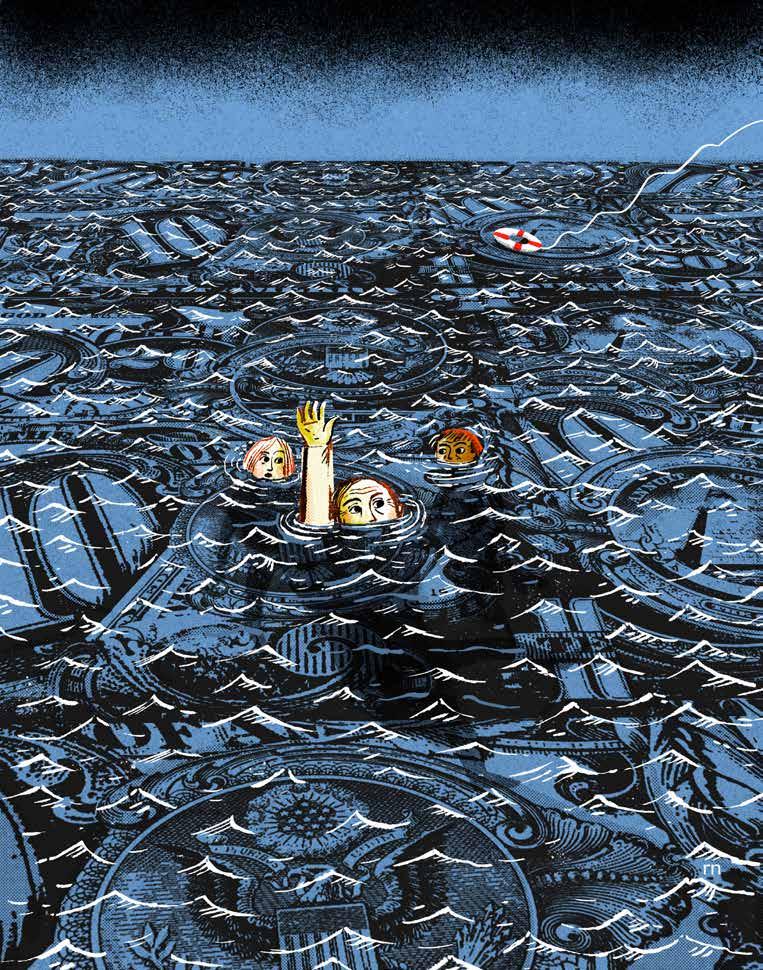
JUNE 2024 69 ILLUSTRATION BY ROBERT NEUBECKER
retirement age, forcing Americans to wait longer to receive full benefits. Or, it could reduce annual cost of living adjustments, which increase benefits after retirement to maintain their purchasing power in the face of rising prices.
None of these ideas are new.
What is new is how little the current president and the man running to replace him have to say about the issue.
Biden has cast himself as a defender of Social Security. “Many of my Republican friends want to put Social Security and Medicare back on the chopping block again,” the president said in his State of the Union address. “I will stop them.”
Politically, this is a potent message, which explains why Biden repeats it so often.
But what the president forgets is that anyone who wants to cut Social Security needn’t chop anything. All they must do is wait: Under current law, benefits will be cut 23 percent when the trust funds run dry, and that is slated to happen all by itself by 2034. And so Biden himself must propose steps to stop benefit cuts, not merely pledge to oppose those who favor reducing benefits.
Seemingly, congressional Democrats delivered just such a plan to the president. In 2019, 89 percent of House Democrats had co-sponsored the Social Security 2100 Act, legislation that would maintain and even increase Social Security benefits and keep the program solvent in perpetuity. That legislation did two things: First, it phased out the “cap” on wages subject to payroll taxes, making all earnings taxable. And second, it gradually raised the 12.4 percent payroll tax rate to 14.8 percent. Together, these tax increases assured that full benefits could be paid, as the act’s title promises, until 2100 and beyond.
How did Biden react? He rejected this plan. As part of his election campaign, Biden pledged not to increase taxes on anyone earning less than $400,000. This eliminated the Social Security 2100 Act’s increase in the payroll tax rate, which supplied nearly half of the plan’s new revenues.
Congressional Democrats introduced
a revised version of their legislation that eliminated the increased payroll tax rate. But instead of maintaining solvency until 2100, this new bill — clumsily retitled Social Security: A Sacred Trust — added only five years to the life of Social Security’s trust funds while still hitting high-income Americans with the largest peacetime tax increase in U.S. history. The “Social Security 2038 Act” doesn’t exactly roll off the tongue.
TO BE CLEAR, I believe that Democrats have the stronger political hand on Social Security. Americans like the program and the nation’s burgeoning senior population would prefer to see someone else’s taxes increased than see their own benefits cut. Nevertheless, the strong hand on Social
WHILE CONGRESSIONAL DEMOCRATS
ROLLED OVER FOR BIDEN’S TAX PLEDGE, THE CONSERVATIVE REPUBLICAN STUDY COMMITTEE HAS PUT OUT A SOLVENCY PLAN THAT DEFIES TRUMP’S WISHES.
Security reform isn’t a winning hand: Making Social Security solvent without reducing benefits involves far larger tax increases than most Americans ordinarily would support. But enabling Social Security to pay full benefits while exempting more than 99 percent of Americans from higher taxes just isn’t practicable. Republicans, for their part, are in an even less enviable position. Traditionally, Republicans have favored addressing Social Security’s funding gap by reducing benefits rather than increasing taxes. President George W. Bush, for whom I worked, argued for a series of benefit reductions that would protect nearly one-third of the poorest of seniors while gradually and
progressively reducing benefits for those with higher earnings.
Trump, as in many areas, is a different kind of Republican when it comes to Social Security reform. He has attacked what he views as the austerity wing of the Republican Party, which seeks to address budget deficits by slowing the growth of entitlement spending. “We’re going to take care of our Social Security,” Trump says. “People have earned that.”
Unfortunately, when it comes to Social Security, the former president appears to have no plan to keep the program solvent. While he has repeatedly pledged never to cut Social Security benefits, he has repeatedly failed to identify a means for avoiding those cuts — which, once again, happen automatically unless the federal government identifies additional revenues for the program. By 2034, Social Security will face annual deficits exceeding $360 billion, and growing. No reduction to so-called waste, fraud and abuse; no expansion of oil drilling; no elimination of aid to Ukraine would fill that gap.
BUT IN THAT void I see the faintest glimmer of hope. While congressional Democrats rolled over for Biden’s tax pledge, thereby dooming their Social Security reform plan, the conservative Republican Study Committee has put out a solvency plan that defies Trump’s wishes by putting benefit reductions squarely on the table.
The committee’s membership includes around 80 percent of House Republicans, including Speaker Mike Johnson. The group produces its own budget proposals, outlining its own favored strategies to reduce the budget deficit and debt without increasing taxes. As part of its most recent budget, released in March, the committee took a shot at Social Security reform. Its proposals “include modest and delayed changes to the Primary Insurance Amount benefit formula, the retirement age, auxiliary benefits for high income earners, and gradually moving towards a flat benefit,” a benefit structure similar to that of the
70 DESERET MAGAZINE IDEAS
United Kingdom, Australia and New Zealand, and one that I favor.
The Republican Study Committee proposes three specific changes to Social Security benefits. First, it would modestly reduce benefits for “individuals who are not near retirement” and whose career-average earnings were over $80,000. This change would make Social Security more progressive by reducing benefits for high-earning Americans.
Next, the committee would “make modest adjustments to the retirement age for future retirees to account for increases in life expectancy.” While the proposed budget is not specific, likely this entails automatically indexing the full retirement age for Social Security benefits to increases in longevity. This indexing would keep the ratio of working years to retired years constant, essentially splitting the gains from longevity on a proportionate basis.
And third, the committee “would limit and phase out auxiliary benefits for high income earners.” This change would, for instance, limit benefits to the nonworking spouse of a high-earning worker.
On cue, congressional Democrats protested: California Democratic Rep. Linda Sanchez declared the Republican Study Committee plan would “end Social Security as we know it.”
In fact, my concern is that the committee’s plan would not change Social Security enough — to make it solvent, that is. The proposal is not specific enough regarding the size and timing of the benefit reductions to come up with a precise estimate, but based on the Social Security Administration actuaries’ projections of similar reforms and my own guesstimates of how much savings are lost by protecting current and near-retirees, I would guess the committee proposals would address perhaps 15 percent of Social Security’s long-term funding gap. That leaves a long way to go.
THE CONSERVATIVE REPUBLICAN Study Committee budget does significantly less to fix Social Security’s long-term funding gap than even the Democrats’ scaled-back
“Social Security: A Sacred Trust” legislation. So the Democrats clearly win on that front.
But where the Republicans win is in defying rather than acquiescing to their leader and presidential nominee. Former President Trump wields power in the Republican Party that Biden, even as sitting president of the United States, does not.
And defying party leadership is what both sides need to do if we are to fix Social Security before a meltdown occurs, a meltdown that could drag the federal budget down with it. Everyone involved in finding a solution knows that it is easier to fix Social Security if we act sooner rather than later and if we spread the pain of tax increases and benefit cuts over as many people as possible.
Yet, for decades, our elected officials have
MEMBERS OF CONGRESS ARE PRIVATELY FAR MORE REALISTIC ABOUT WHAT SOCIAL SECURITY REFORM WILL INVOLVE THAN THEIR PUBLIC STATEMENTS WOULD BELIE.
failed to act on that precept. The reason, for them, is simple: Even if early action on Social Security is better for the country and the economy, it is not better for the politicians who have to carry it out. They must tell Americans that the deal they have been sold — if you pay this percentage of your income into Social Security while you’re working, you’ll receive back benefits based on that formula — must be broken. While politicians talk about keeping promises, Social Security reform, mathematically, can be about little other than breaking promises. If politicians must break promises, by raising Social Security taxes or reducing benefits, the best way is to do it together.
Indeed, together is the only way Social Security is likely to be saved. One lesson
in U.S. politics is that it’s very difficult to enact significant policy changes on a party-line basis. President Bill Clinton attempted to reform health care and failed. President George W. Bush staked his political capital on Social Security reform, which didn’t even come close to passing through Congress. President Barack Obama succeeded in passing the Affordable Care Act, but by the thinnest of margins at a time when Democrats held huge majorities in both the House and Senate. Our political system, unlike those of nations with parliamentary systems, just isn’t built for big changes.
But we cannot simply issue more debt to paper over Social Security’s funding gap. Researchers at the Wharton School of Business recently concluded that, on its current track, “the United States has about 20 years for corrective action after which no amount of future tax increases or spending cuts could avoid the government defaulting on its debt.” Adding Social Security to the debt burden could bring on a crisis even sooner.
That is why a bipartisan entitlement commission, such as the one proposed in the bipartisan Fiscal Stability Act co-sponsored by Sens. Mitt Romney, R-Utah, and Joe Manchin, D-W.Va., is probably the best hope for Social Security reform before a crisis hits. Some protest that important policy changes should not be made behind closed doors. And I would agree, if three decades of open-doors policymaking had not clearly failed to bring a solution. Moreover, having spoken to members of Congress behind closed doors, I can say they are far more realistic about what Social Security reform will involve than their public statements would belie. Republicans have admitted to me that tax increases are likely; Democrats have said that a higher retirement age may happen, too. To save Social Security, politicians must, for a moment, put politics aside.
JUNE 2024 71
ANDREW G. BIGGS IS A SENIOR FELLOW AT THE AMERICAN ENTERPRISE INSTITUTE AND A FORMER PRINCIPAL DEPUTY COMMISSIONER OF THE SOCIAL SECURITY ADMINISTRATION.
WINDOW ON A HILL
A NEW LENS FOR THE CITY THAT ROSE FROM THE DESERT
BY JOE MAROTTA
The terrain of upstate New York, where I grew up, consists primarily of rolling hills and mountains, or what we called mountains. They had little in common with their towering cousins out West, so if you lived in one of the many small cities scattered across the region, your sight lines were very limited. I could see the streets of Albany as they extended up from the Hudson River, from the opposite shore, but that was about it. So it would be an understatement to say my sense of visual space was radically changed when I moved to Salt Lake City in 1978.
The University of Utah, where I would spend 40 years teaching photography and its history, sits in the foothills of the Wasatch Range. Now these were mountains! The western edge of the Rockies ran 160 rugged miles between central Utah and the Idaho border. But my office window faced west, where I could see the entire city, the whole valley, the lake, Antelope Island and beyond. I was sure that if I climbed to the top of one of those nearby peaks, which ascend nearly 12,000 feet above sea level, I could see the curvature of the earth.
Sometimes, I would walk downtown
with my camera. It had so much character, having mostly eluded the federal urban renewal projects of the 1950s and ’60s that decimated the aesthetic and historic aspects of so many cities, including Albany. Even New York City’s Penn Station — with its lofty glass ceiling, it felt like being in a cathedral — was demolished in 1963, replaced with a subterranean train
SALT LAKE CITY WAS STILL A FRONTIER SETTLEMENT IN 1850, WHEN THE FIRST PHOTOGRAPHER BROUGHT HIS CAMERA TO TOWN.
IN A WAY, THE CITY AND THE ART FORM WOULD CHANGE AND GROW TOGETHER.
station with demoralizing low ceilings. I remember seeing images of Europe after World War II as a teenager and thinking, “We didn’t need a war to destroy our cities, we did it ourselves.”
But Salt Lake City was still relatively intact. In fact, I recognized many buildings
from the work of Charles Roscoe Savage, an important 19th-century photographer known for his images of the Western landscape. He lived here for most of his life, and from 1860 to 1909, he tracked the growth of this small Western town as it became a major American city. Watching that same city grow from my office window in the foothills, I developed a deep appreciation for his work — and that of a few skilled contemporaries — which helped to create a unique photographic legacy: a visual record of a modern metropolis rising from the desert.
I HAVE BEEN around long enough to know that things change, whether that means the passing of seasons (the stasis of winter to the rebirth of spring) or the evolution of cities across the centuries. These we’ve come to expect, but some changes shifted the direction of history completely, changes so definitive, there is now a before and an after. Certain inventions have that power, like the microchip (imagine life without a smartphone) or the internal combustion engine (which gets us from point A to B effortlessly, barring traffic). And then there’s photography.
72 DESERET MAGAZINE CULTURE
RIGHT: MAIN STREET AND 2OO SOUTH FACING SOUTHEAST, CAPTURED BY CHARLES ROSCOE SAVAGE IN THE 1880S.
BELOW: CONTINENTAL BANK ON THE SOUTHWEST CORNER OF THE SAME INTERSECTION, 1938, BY CLIFF BRAY.




JUNE 2024 73
UTAH STATE HISTORICAL SOCIETY UTAH STATE HISTORICAL SOCIETY UTAH STATE HISTORICAL SOCIETY JOE MAROTTA
CENTRE THEATRE (1937, SALT LAKE TRIBUNE STAFF) AND KEN GARFF TOWER (2024, BY THE AUTHOR) AT 300 SOUTH AND STATE STREET.
In 1859, Oliver Wendell Holmes called the camera “the mirror with a memory.” Its advent changed everything. For millennia, we had only written and visual interpretations of what the world and the individuals who populated it looked like. The closest we came to reality was an artist’s rendering. No wonder one of the main objectives of fine art throughout that time was to depict its subjects as accurately as possible. The Dutch artists of the 1600s were masters of this kind of realism. But later, the rise of industrialization called for a faster, less expensive and more accurate method. Discovered in 1839, photography filled that need. By 1853, this new craft was becoming more widely practiced and affordable. We know what Paris looked like that year because there are photographs to show us. London, Rome and other world capitals quickly became accessible to people who would never set foot there. In 1854, André Adolphe Eugène Disdéri introduced the carte de visite, a small, inexpensive photo card that visitors could take home to remind them of their experience. Produced by the thousands, these predecessors of the familiar postcard depicted famous places, people and everyday street life. By 1888, the Kodak camera put that power into the
hands of ordinary folks who could now capture their own images, providing evidence that they were there, like a photo with the Eiffel Tower in the background. Legitimizing the experience. Providing proof.
At that time, cities like Paris, Tokyo and Buenos Aires had been around for centuries or millennia. Even New York was quite established. But Salt Lake City was still very much a frontier settlement in 1850, when
IT WAS THEIR CITY, THEIR PARENTS’ CITY, THEIR GRANDPARENTS’ CITY. THESE IMAGES ESTABLISHED A LINK TO A PERSONAL PAST AND A COMMON HISTORY.
the first photographer brought his camera to town. He would be followed by several notable practitioners who enjoyed the patronage of a local culture that knew they were making history and wanted it to be recorded. Together, they created a unique visual history. In a way, the city and the art form would change and grow together.

MARSENA CANNON CAME to Salt Lake City in 1850, leaving his Boston studio to become the first commercial daguerreotypist established in the Intermountain West. Born in Rochester, New Hampshire, in 1812, he had converted to The Church of Jesus Christ of Latter-day Saints. His focus was portraiture, with clients ranging from local residents to church leaders. He even took one of the earliest daguerreotypes of President Brigham Young. But he did also capture some views of the city. His business was successful, but another arrival would soon join him. Savage was young, but he was no novice. Originally from Southampton, England, he had also converted to the Church of Jesus Christ before immigrating to New York City in 1856, at the age of 23. He worked in a print shop and practiced taking stereographic photos with a friend, the first such images of Long Island. It is believed that he learned from established daguerreotypists like Edward Covington. When he and later his family moved West, he started selling portraits in Florence, Nebraska, and Council Bluffs, Iowa. In the 1860s, they crossed the plains to Salt Lake City, where he took out his first ad in the Deseret News and soon partnered with Cannon.
This was a time of Western expansion. The federal government sent out expeditions to survey and document the land in the 1860s and 1870s, and photographers were important members of these expeditions, which would stop in Salt Lake City for supplies. In 1861, Cannon moved his family to St. George, and Savage then partnered with painter George Ottinger, who would hand-tint Savage’s photos, producing color photographs. After their partnership ended, Savage opened the Pioneer Art Gallery, taking portraits, selling views of the city and landscapes of the state, and selling equipment to photographers passing through. When he wasn’t behind the camera, Savage was an ambitious and successful entrepreneur. Beyond portraits and documentary landscapes, he made scenic views of the growing city. He produced large single views, stereo cards and cartes de visite, many
74 DESERET MAGAZINE CULTURE
CHURCH HISTORY LIBRARY MAIN
THE POST OFFICE AND THE CITY’S FIRST
STREET, SHOWING
STORE, IN 1864 BY MARSENA CANNON.
hand-tinted by Ottinger. He also worked for the Union Pacific and Rio Grande Western railroads, traveling along each line and shooting landscapes. He was one of three photographers to capture the meeting of the rails at Promontory, Utah, on May 10, 1869. He also documented the construction of the Salt Lake Temple, from the cutting of granite stone in Little Cottonwood Canyon, to the completion of the building itself — a historically significant achievement.
Savage was passionately interested in photography as a way of preserving history and constantly developed his own skills. When he saw Carleton Watkins’ extraordinary landscape views, he traveled to San Francisco to ask the man how he made them. He traveled to New York to catch up on technical improvements and arranged for a gallery there to carry his work for sale. He became, by the 1880s, one of the most successful and respected photographers in the country.
But what makes Savage interesting to me is not the mere fact that he documented Salt Lake, but the way he did so. It is very evident that he spent time with his subject to get the right atmosphere to visually convey something about the city. By the late 19th century, there were a number of excellent urban photographers, but only a few used light and atmosphere to capture their subject aesthetically. Charles Marville and Eugène Atget in Paris and Frederick Evans in London are good examples. There is an emotional connection with the subject, almost an affection. Savage worked in this way too.
His images are well composed, seen from the best vantage point, and made with the best technical developments of his time. His use of light and shadow gives his images a sense of specific time and place. His streets are often populated, which makes the image more intimate and helps connect the viewer to the scene. They make you want to walk down that street, look in that shop window, maybe see a friend and stop to talk for a while. In this way they become personal histories.
Over the decades, Salt Lake City changed in scope and ambition, becoming a vibrant, contemporary city by the early 20th century. Photography changed with it. Film replaced glass plate negatives. Cameras became smaller and faster. The growth of newspapers and magazines increased the demand for images. Photojournalism became the leading form of photography from the 1920s through the 1960s, with the city as its main subject. In this manner, newspapers like the Deseret News and The Salt Lake Tribune showed people what their city looked like from different perspectives, making their own home more familiar and accessible. It was their city, their parents’ city, their grandparents’ city. These images established a link to a personal past and a common history.
WHAT MAKES SAVAGE INTERESTING IS NOT THE MERE FACT THAT HE DOCUMENTED SALT LAKE, BUT THE WAY HE DID SO. THERE IS AN EMOTIONAL CONNECTION WITH THE SUBJECT, ALMOST AN AFFECTION.
WHAT MAKES A city unique? What separates this one from that other one, as a place where lives are lived and memories are made? Here, for decades, that might have meant breakfast at the Judge Café, or that dress you bought at Keith Warshaw’s or Auerbach’s or ZCMI. Or coffee at the Woolworth’s counter or Lamb’s Grill. Or a movie at the Centre Theater, with over a thousand seats and a massive 56-foot screen, demolished in 1989. Images of these places and so many others can be found in the Utah State Historical Archives, the Church History Library, the BYU archives, the Deseret News and Salt Lake Tribune archives, the Marriott Library Collection and books like
“Seeing Salt Lake City: The Legacy of the Shipler Photographers,” which focuses on a later period.
At first, you might find yourself captivated by the images of buildings that no longer exist. I remember sitting in the balcony of the Utah Theater in 1988, watching Marcello Mastroianni in “Dark Eyes.” Originally called the Pantages Theater, it had 2,300 seats and a Tiffany glass ceiling! And it was there for everyone to enjoy, for the price of a movie ticket. No matter your income level, you could enter this grand historical space and connect with a shared experience. It felt like a little bit of democracy at work. After closing that same year, the theater sat ignored until 2022, when it was demolished to make room for a glass and steel high-rise apartment building that remains unconstructed. Two years on, there remains for me a gaping hole on Main Street, both literally and metaphorically.
But I’ve said this before. Cities change. And we’re fortunate to still have a wealth of historically significant buildings downtown, like the Capitol Theatre, the façade of the old Lyric Theatre, the Joseph Smith Memorial Building (formerly the Hotel Utah), the Walker Bank building, and the Rio Grande and Union Pacific train stations. There are many others. The Continental Bank building is now the Hotel Monaco, repurposed rather than torn down, which feels perhaps wiser to me than removing something special to replace it with something modern but ordinary.
In the four decades since I moved here and fell in love with this place, I’ve traveled extensively to photograph architecture and street scenes in Paris, Rome, London, Lisbon, Mexico City and New York. But I always find something interesting to photograph right here at home. Walk around downtown Salt Lake City. Spend an hour. See how it feels. Get to know it firsthand. Of course it has changed in its 176 years — sometimes for the good, sometimes not. But you can judge for yourself because we still have the photographs, a rich history of the city rising from the desert.
JUNE 2024 75

Experience personal growth, humanitarian service, and cultural exchange.



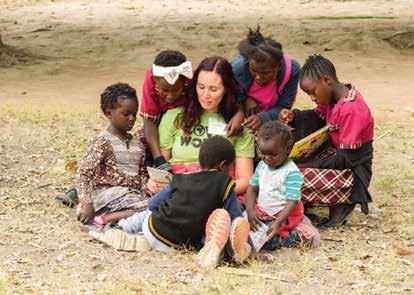
Apply for a summer expedition at MothersWithoutBorders.org/Expeditions

COME TO AFRICA
SEVEN WAYS OF SAYING
BY JOHN BELK
I.
ebullient is one of the prettiest words — much better than its cousins, cheerful and bubbly, more rounded than effervescent, trombone to fizzy French horn. I often get hung on meanings of things: the difference in tenor between moonsong and heartache or almost-sadness in a trailing voice leaving on grand adventure. I over-interpret and dig — glean seeds off heads of grass-sprout and keep them in my pocket like words I never learned from ancient, unknown tongues.
II.
I have apologized more times than I know. It is strange to think so little of it: apo- away, from, a prepositional pushing off. -logia, from logos, the word that was with God and the word that was God in the very beginning when we first found each other through groping, animal noise.
III.
Some people talk by skin and teeth and tightness in their shoulders you can feel across a room. Some people talk by touch — all fingers-and-toes for participles and clumsy hand-holding for love. Some people talk in silence, in lonely moments at daybreak or painful moments in bathrooms or fleeting, wordless moments of just-about-ok or I-can’t-tell-you-now or please-please-don’t-go.
IV.
Greek has a mood for things that could happen and things that should happen, but haven’t and might well not. It’s useful for saying, If I were god or Should I descend the stair or I wish I were an acrobat or Would only that she cared.
V.
There is complexity in knowing without words, divining feeling from blood and bones and muddled leaves of tea: a turn of cheek, a brush of hand, a smile borne sideways on breeze. When I was young I tried explaining terror: a robin crushed by a toppled logtruck in the prettiest of dreams, a loved one leaving without a sound or farewell front-door creak. I tried explaining care, too, the drive to give away: a portion of me for winter nights, a portion for dwindling days, a portion for the sabbath and things we cannot keep, and a portion I’m still not sure about —
VI.
breathless is my favorite word — layered like birthday cake with buttercream and custard fill and apricot preserves. It carries short-term sadness — momentary hurt held only as long as a diaphragm can spasm before giving up its ghost. It is dizzy shock and awe contained in tabernacle walls. It is crush and carbonated panic, when a brain deprived of air thinks Surely not here — not this way before a body, suddenly, and with every good reason, sharply draws in sky.
VII.
How many ways to say the same thing: I love you. A robin stood at the head of the drive and reminded me of you. The great Li Po, on a bamboo horse, sang of childhood rivers, longing, bittersweet cups of wine, and you. It is silly: this constant falling, this ebullient animal tumble, this dizzy, over-worded, breathless groping to some place only named in ancient, unknown tongues.
JOHN BELK IS AN ASSOCIATE PROFESSOR OF ENGLISH AT SOUTHERN UTAH UNIVERSITY AND AUTHOR OF THE POETRY COLLECTIONS “THE GARDENS OF OUR CHILDHOODS” AND “THE WEATHERING OF IGNEOUS ROCKFORMS IN HIGH-ALTITUDE RIPARIAN ENVIRONMENTS.”
JUNE 2024 77 POETRY CURATED BY UTAH POET LAUREATE LISA BICKMORE
CAST AWAY
BY ETHAN BAUER
It rained the first time I went fishing with the woman who would become my wife. The water soaked through our clothes, and I wondered whether she would stay, but I could not leave. I’d brought a bucket of spoon-sized silver fish called shiners, acquired from a scuffed white tank at a gas station, and I couldn’t go home until I’d hooked each one through the lips; flicked ’em into the gray, stagnant water; and found out what lurked beneath the chop. All day the sky spit at us. So did the fish. Cast after cast, they’d steal shiner after shiner. But their nibbles gave me hope, and I’d saved the fattest, liveliest one for last.
I wasn’t after cutthroats or sturgeon, since they don’t exist in my childhood home of South Florida. But thanks to released overgrown pets and forgiving tropical waters, any given cast there can yield a 150-pound redtail catfish from the Amazon; a spotted tilapia from West Africa; or a feather-bodied clown knifefish from Southeast Asia. The kings are peacock bass — a colorful, hard-fighting species native to the Amazon River basin with three bold, vertical stripes — but I’ve always found their superiority too narrow. The real joy of fishing can be found in the ambiguity. The uncertainty.
That feeling when a fish first bites, and the rod bends, and you might pull something from the water you’ve never seen before. For a few transcendent seconds, you’re riveted to a moment. No urge to check your phone. No conversation to be had, aside from the requisite, “Got one!” Just you, and whatever fish you’re fighting. Shiners dangled beneath a bobber, especially, provide real theater. The bait does all the work, wiggling into view of waiting predators. The tension grows. Anything, at any moment, could burst from the reeds and make the reel wheeze. When it does, the world melts, and you forget everything except the hope of what’s to come.
Like when something snarfed down the fattest, liveliest shiner in the bucket, on the last cast of the day. The rain and the gray sky and the soaked clothes and the bad luck vanished as I set the hook and reeled until three vertical stripes flashed in a flurry. A peacock bass — the biggest I’d ever caught, it turned out. What a thrill it was to see it, finally, and snap pictures. What a thrill it was to share it with someone who, I knew for the first time that day, would stick with me through anything.
And what a thrill it was, most of all, to have waited for it.
78 DESERET MAGAZINE ODE
AN ODE TO LIVE BAIT
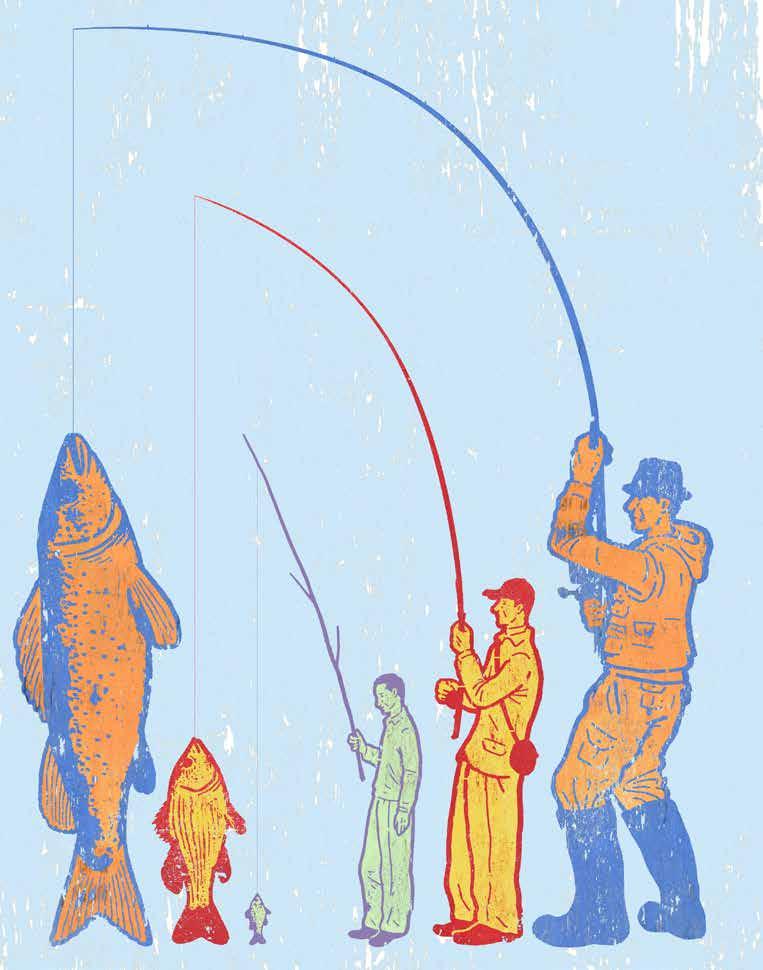
JUNE 2024 79 ILLUSTRATION BY DAN PAGE

THE CHAPLAIN
AIR FORCE CAPT. JENNA CARSON ON SPIRITUALITY IN THE MILITARY
BY LOIS M. COLLINS
Chaplains play a unique role in the American military — and in our conception of spirituality. Each one is endorsed for the role by the church or faith organization they belong to, but on the job, they minister to individuals from all manner of religious traditions, including atheists. Since the Department of Defense lets them work 100 percent confidentially, folks in the service trust them deeply, no matter their beliefs.
Chaplain Capt. Jenna Carson loves to preach — loves everything about it, from reading and meditating on scriptures to craft her message to the feeling she gets when she stands at the pulpit, heart fluttering briefly before she feels a little surge of power and starts to speak. But she likes counseling, too, and listening to those who
come to her with questions, confessions, joys and sorrows.
A former missionary for The Church of Jesus Christ of Latter-day Saints (she served in Tampa, Florida), Carson is now the first female Latter-day Saint chaplain in the United States military. Her days at Keesler Air Force Base in Biloxi, Mississippi, are very different from what she expected while majoring in English at BYU, hoping to become a teacher. An astute professor suggested she attend Harvard Divinity School, where she learned about chaplaincy and embraced a three-year Master of Divinity path.
Carson says she felt a call to serve that was decidedly strange. Her faith didn’t have female military chaplains at the time, and she’d never been drawn to the service. Still,
she asked. Then she asked again, every few months. She became a hospital chaplain, then a federal prison chaplain. Along the way, she divorced. But in 2021, a call from church headquarters let her know that single men and women could be now endorsed as chaplains on a case-by-case basis. She was commissioned an officer and chaplain in the U.S. Air Force in July 2022.
Now, she devotes her days to helping men and women of all backgrounds in whatever way she can, whether that means listening, preaching or just showing love. “Often, when I’m counseling, I’m just praying to know what to say and what not to say. I want to allow them to make meaning and find what they need to receive support in their life — sometimes spiritual, sometimes more secular.”
80 DESERET MAGAZINE THE LAST WORD
JENNA CARSON
Carson spoke to Deseret Magazine about her work with a mandatory disclaimer, required to obtain permission for this interview: Her views are her own and not those of the U.S. Department of Defense.
WHAT DOES A MILITARY CHAPLAIN DO?
Besides counseling and preaching, we provide invocations at military ceremonies and advise leaders on moral, ethical and religious matters. We are officers and complete mandatory professional education during our careers. We also officiate weddings and funerals, although I have not yet had the chance. My days are mostly filled with counseling sessions and invocations at different events and ceremonies. I also teach a “Mindful Monday” class on the base each week, guiding participants through mindful movement and meditation.
WHAT’S IT LIKE TO MINISTER TO THOSE WHO DON’T SHARE YOUR FAITH?
I’m there to listen and speak with the most unbiased, nonjudgmental presence I can muster. Sometimes people have a strong religious belief and we talk about God. But when people have had bad experiences with religion, I might just lead them through a meditation to help them find calm and feel grounded. There are theological differences, but I love learning about all spiritual backgrounds. I think it’s a gift to be open-minded.
HAS THAT CHANGED HOW YOU VIEW YOUR OWN SPIRITUALITY?
I have to walk a careful line. I need to remember that I am rooted in a religious tradition. I lean on a metaphor I developed in graduate school. I see myself as a tree. The roots keep growing deeper, like my relationship with Jesus. But the branches extend outward. I like to think these other religious traditions are feeding me and helping me to grow and expand my view.
WHY CHAPLAINCY?
It reminded me of my Latter-day Saint mission, but without proselytizing. I meet
people where they are, with no agenda of my own, and hear their stories without trying to pull them in any direction. That felt like a sacred space because I love listening to people and supporting them. There was a time I thought about becoming a therapist, but I wanted to be able to talk about God. Chaplaincy is the best of both worlds. I’m not a mental health professional, but I do basic short-term counseling. And if people want it to be focused on a higher power, that’s just a special world. That drew me in. I had never considered joining the military until I felt that call.
training school. It was almost nine weeks. Trust me, I was counting every day. I put in a lot of work to get my body stronger beforehand, but it’s hard to prepare yourself for the heat in Alabama in August and September. But it was more challenging to me mentally. It was a whole new worldview that I had never experienced and I did not feel like I fit in. I was like, what did I sign up for?
YOU STUCK IT OUT. WHAT’S THE HARDEST PART OF YOUR JOB NOW?
“I’M THERE TO LISTEN AND SPEAK WITH THE MOST UNBIASED, NONJUDGMENTAL PRESENCE I CAN MUSTER. THERE ARE THEOLOGICAL DIFFERENCES, BUT I LOVE LEARNING ABOUT ALL SPIRITUAL BACKGROUNDS. I THINK IT’S A GIFT TO BE OPEN-MINDED.”
WHAT IS THAT LIKE AS A WOMAN?
There are not a lot of women in military chaplaincy. And I had a strong desire to serve women who have faced a lot of difficulties in the service. But there are also a lot of men who come to me. And I’ve been surprised at the openness of some of them to see me as a spiritual authority. As a chaplain. That’s something that I wasn’t quite expecting.
DO CHAPLAINS HAVE TO GO TO BOOT CAMP? WHAT WAS THAT LIKE?
Boot camp was one of the hardest things I’ve ever done. I went through officer
Life in the military requires a lot of mental resilience. I try to be structured and take care of myself. Hearing all the things people share can take a lot out of you emotionally but also physically. I process a lot by journaling and I also practice yoga, but sometimes I need to stop doing and just be and breathe and read and nap. Sometimes I cannot go out and be social. I need to conserve my energy and guard my personal time. I’m an introvert. I love people, but I replenish my energy alone.
WHAT HAVE YOU LEARNED ABOUT PEOPLE?
We’re all basically the same at a fundamental level; everyone just wants to be happy and safe and loved. When we hurt each other, it comes because we ourselves are hurt. I’ve worked in a prison with people who have had some hard life circumstances and found much of the same in the military. A lot of these amazing young people are here trying to create a better life. They might struggle, but I think God’s mercy is greater than anything I could imagine.
ANY LAST WORD?
With God I feel so strong, I feel so empowered. I’m a lot more assertive than I used to be. The more broken I realize that I am and the more I need God, the easier it is for me to see that I’m just the same as everyone else. I’m not closer to God or truth because of my position. I’m just here to walk the path and support. And I need support like everyone else does.
JUNE 2024 81
ILLUSTRATION BY KYLE HILTON

82 DESERET MAGAZINE PARTING SHOT
SAN JUAN MOUNTAIN WILDFLOWERS | PHOTOGRAPHY BY AUSTIN PEDERSEN
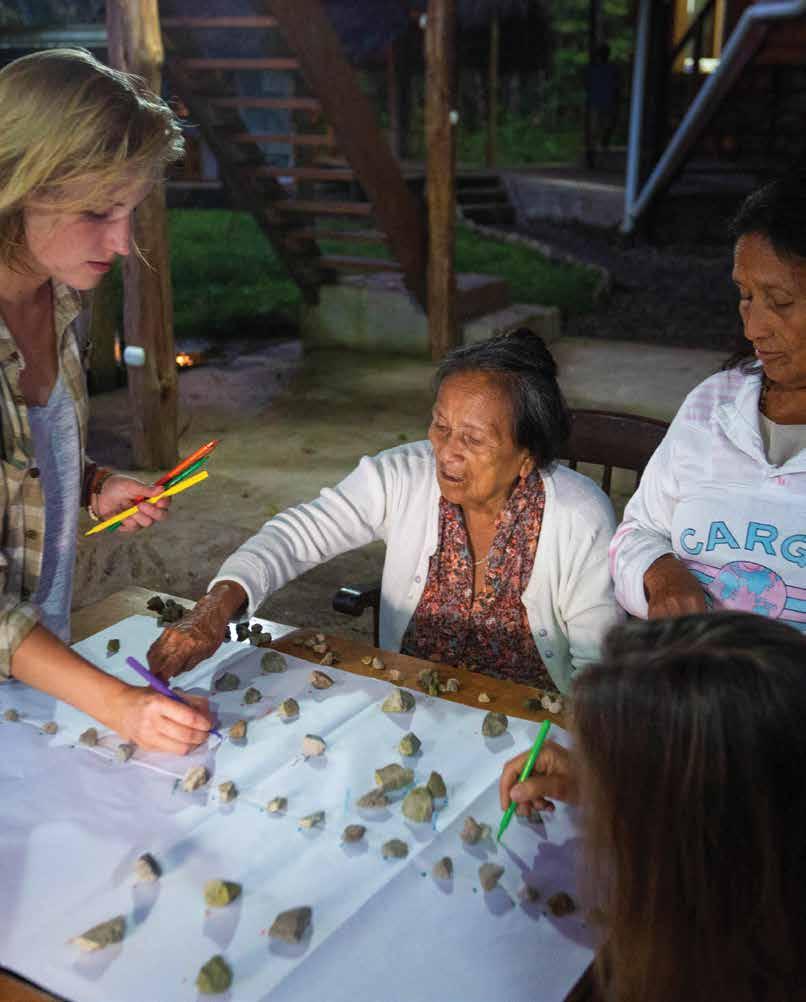
In Ecuador’s rainforests, a 2,000-year-old unwritten language is connecting cultures. By learning Quichua from the speakers who keep it alive, Brigham Young University students see the world in a new light and strengthen bonds that we have with each other.
Learning by study, by faith, and by experience, we strive to be among the exceptional universities in the world and an essential university for the world.
BYU.EDU/FORTHEWORLD

Drive Your Dream Car Today Enjoy low auto loan rates starting at just 6.49% APR*. Get behind the wheel sooner! www.dfcu.com RATES STATED AS ANNUAL PERCENTAGE RATE. MEMBERSHIP AND ELIGIBILITY REQUIRED. OAC. TERMS AND CONDITIONS APPLY. *
JUNE 2024 I SSUE 35 35

RETURN OF THE CONDOR:
THE COMEBACK OF A WESTERN ICON IS THERAPY CAUSING THE TEEN ANXIETY CRISIS?
SOLITARY
CONFINEMENT:
A UNIQUELY AMERICAN PHENOMENON
PLUS: ALAN J. HAWKINS CONFESSIONS OF A BORN-AGAIN TRAVELER
JUNE 2024 VOL 04 | NO 35






























 natalia galicza
natalia galicza





















































 BY
BY
































